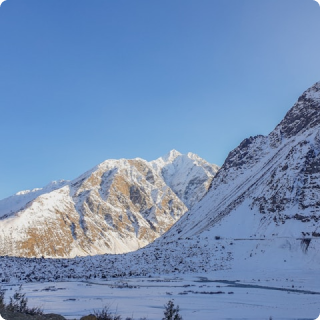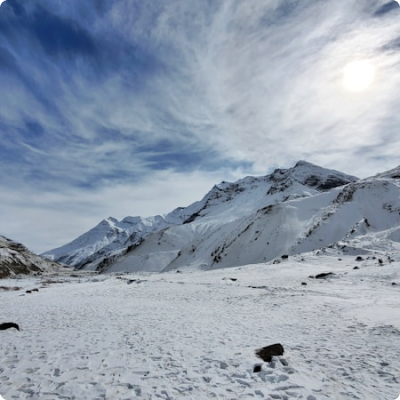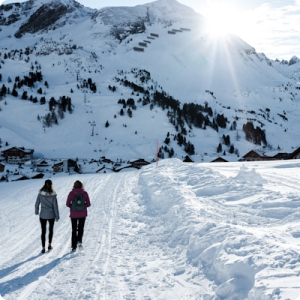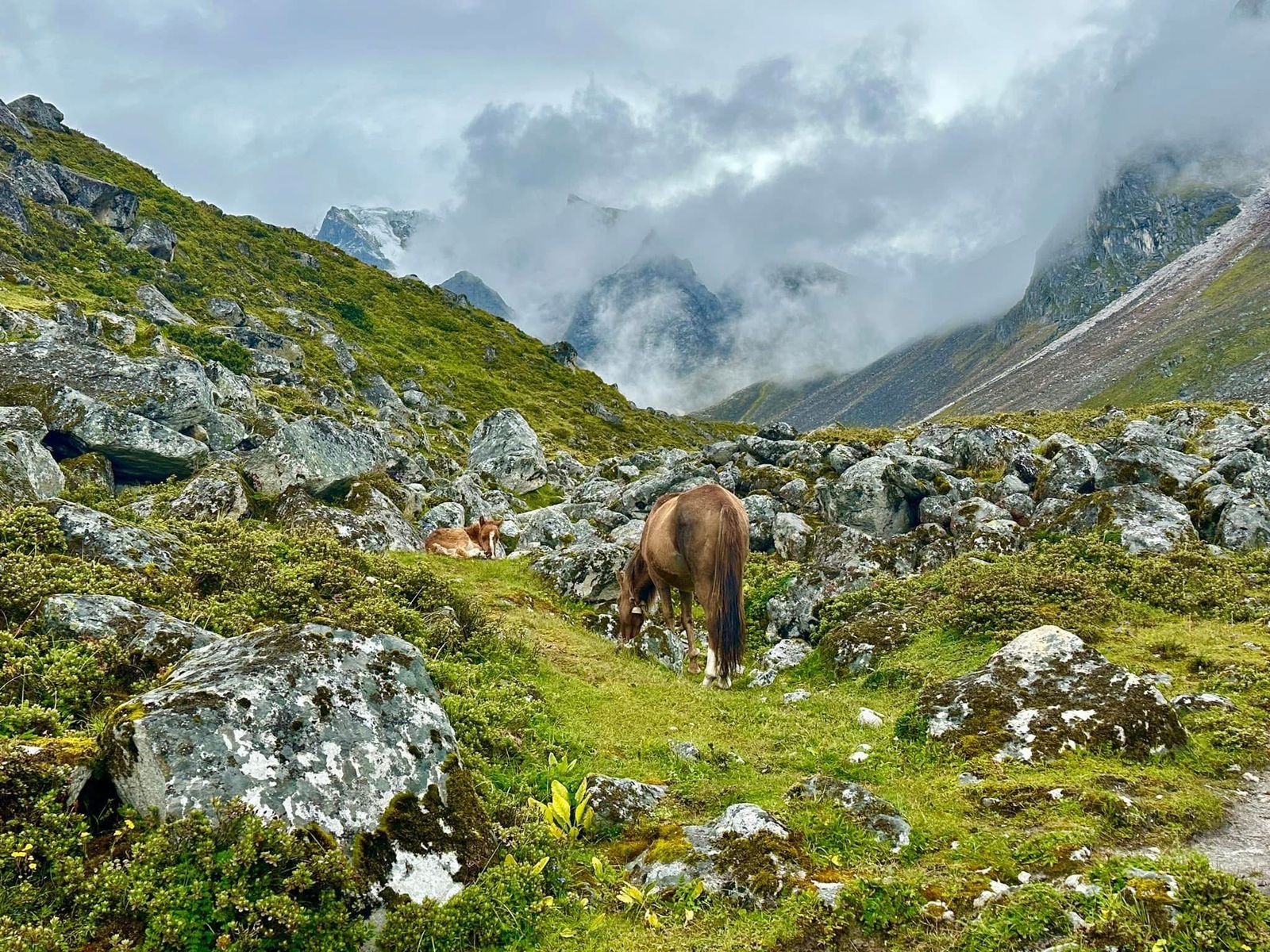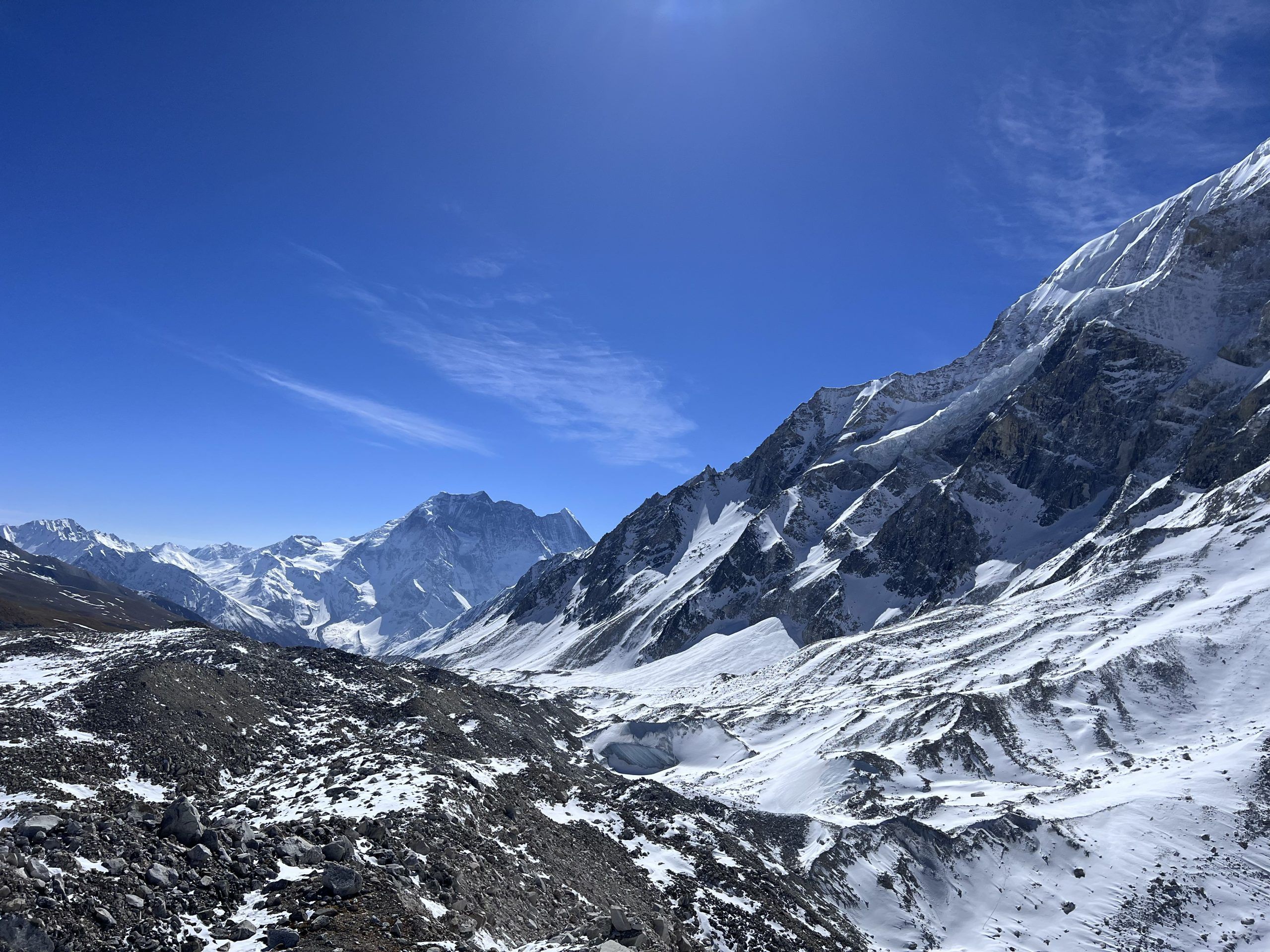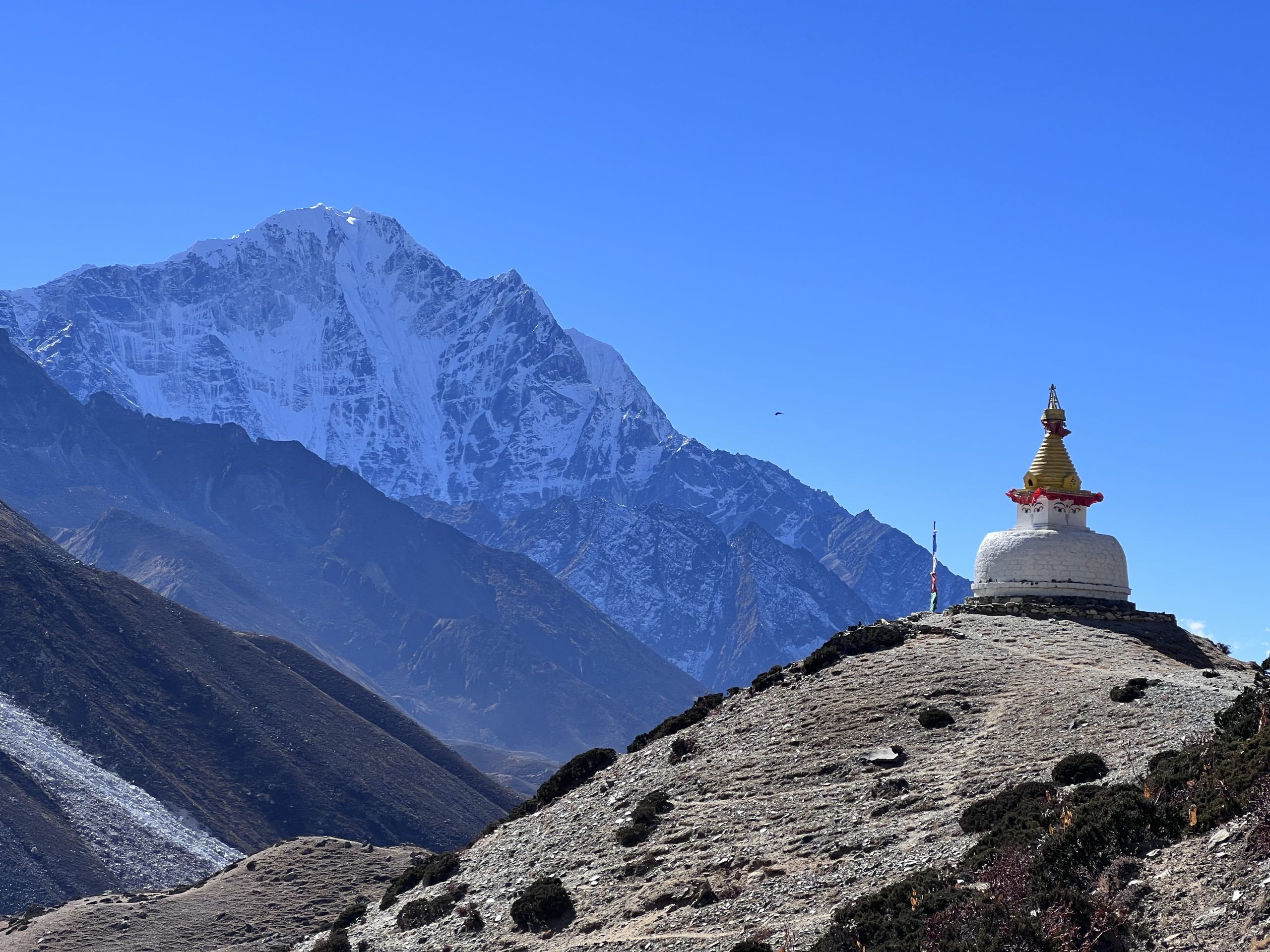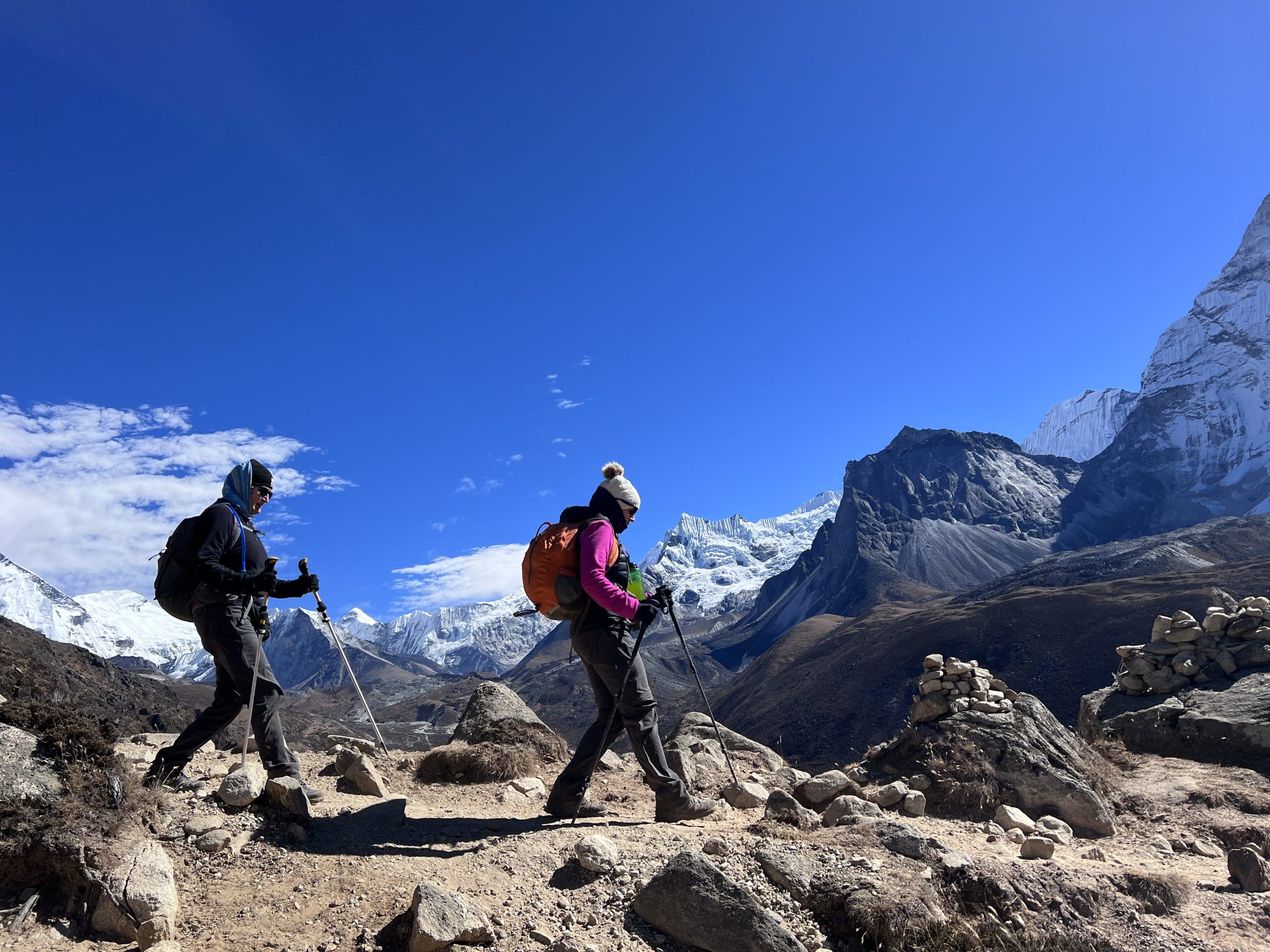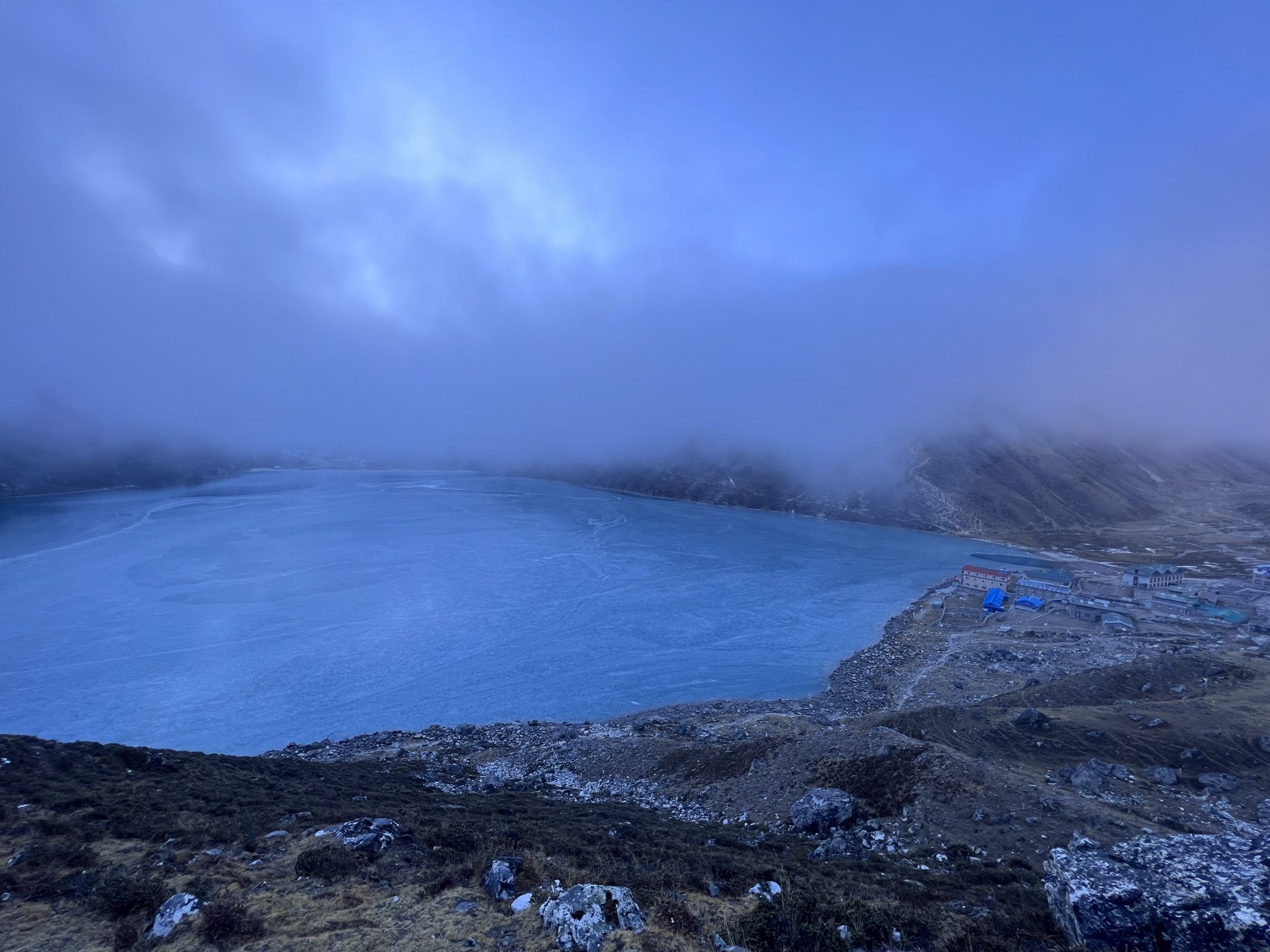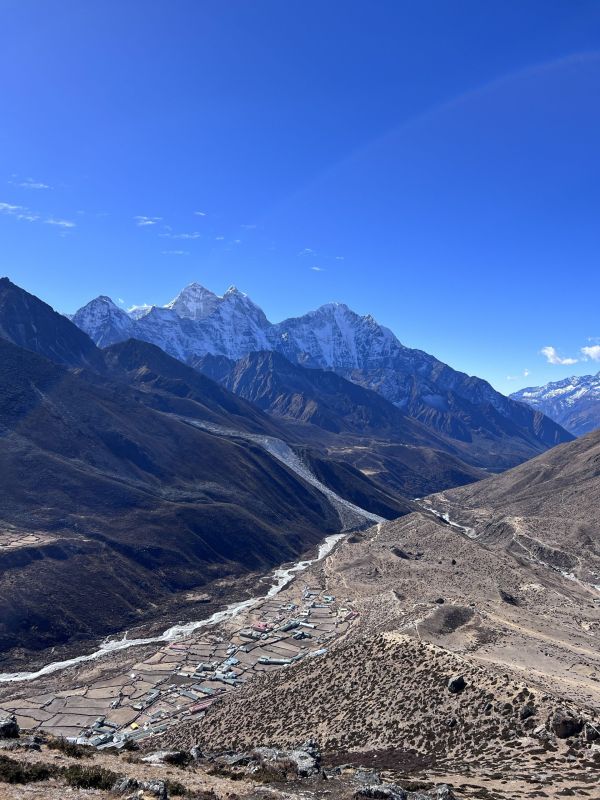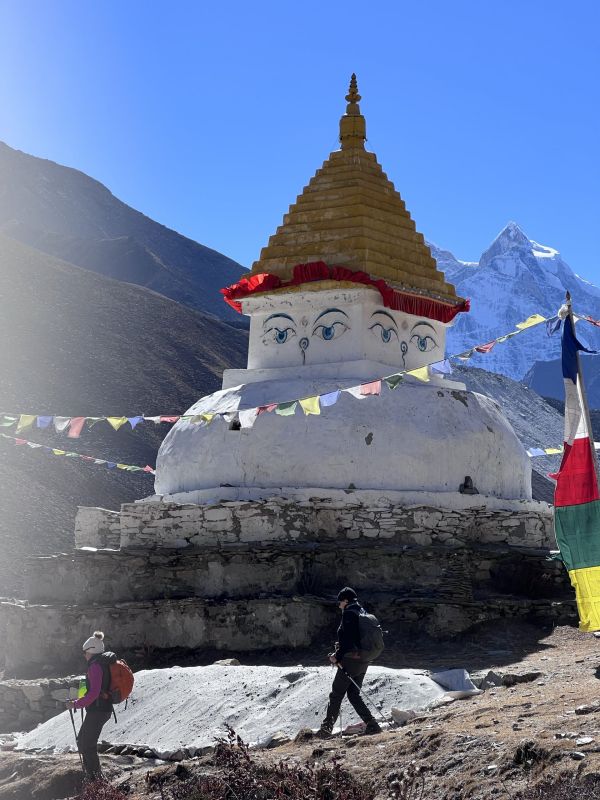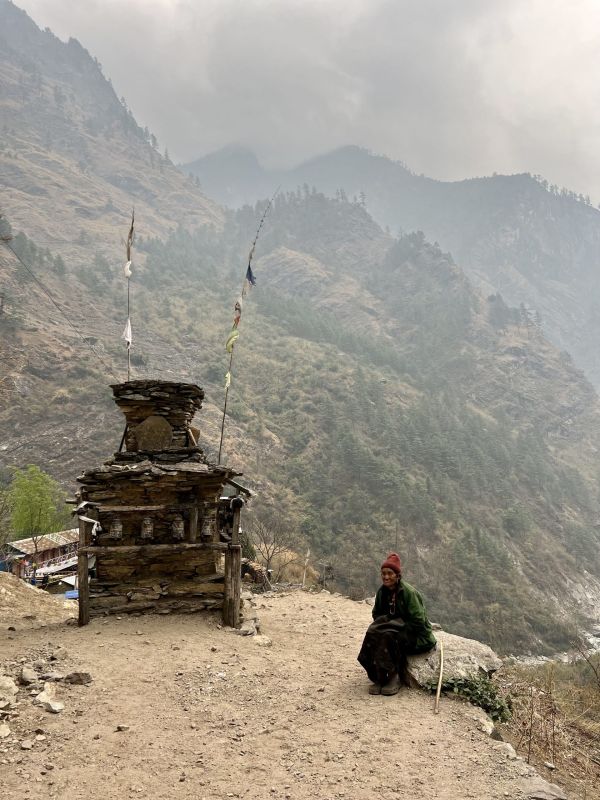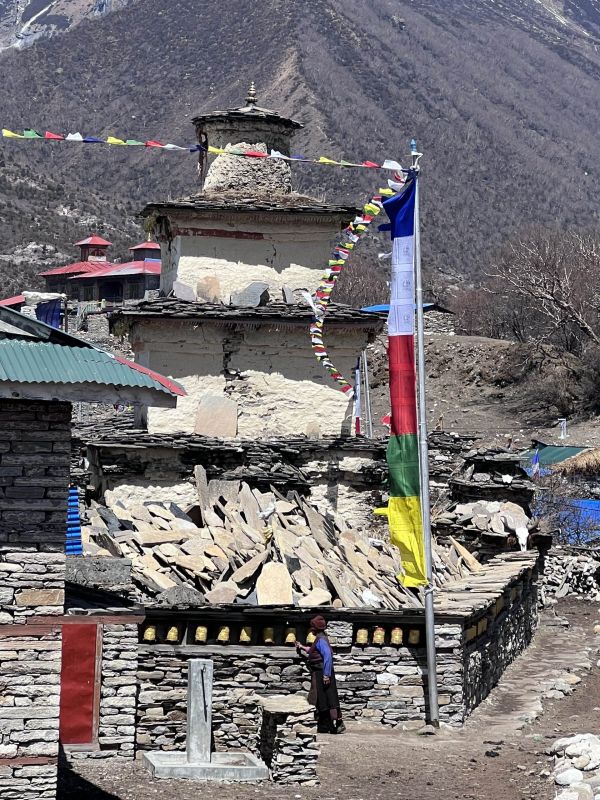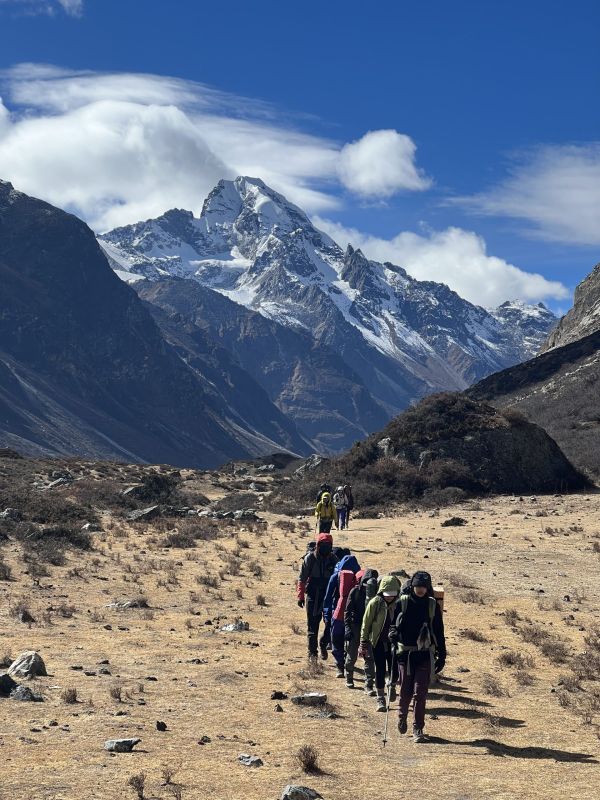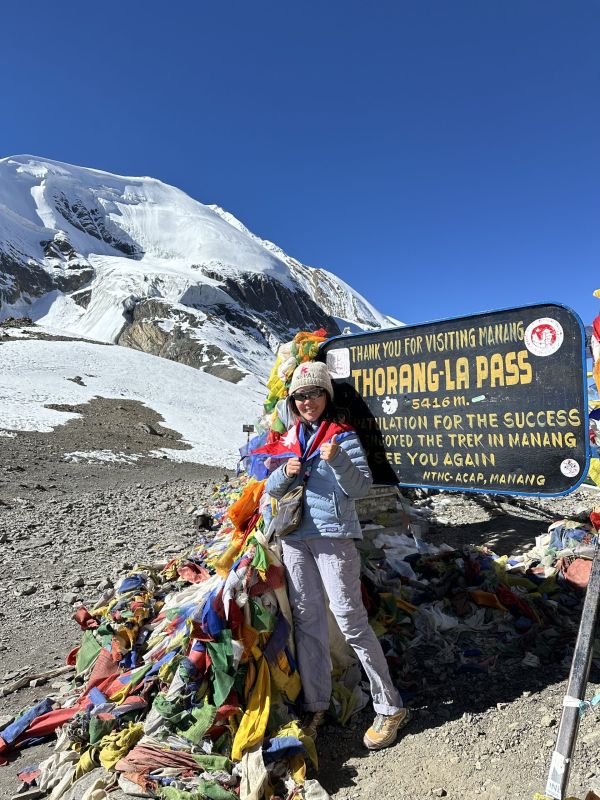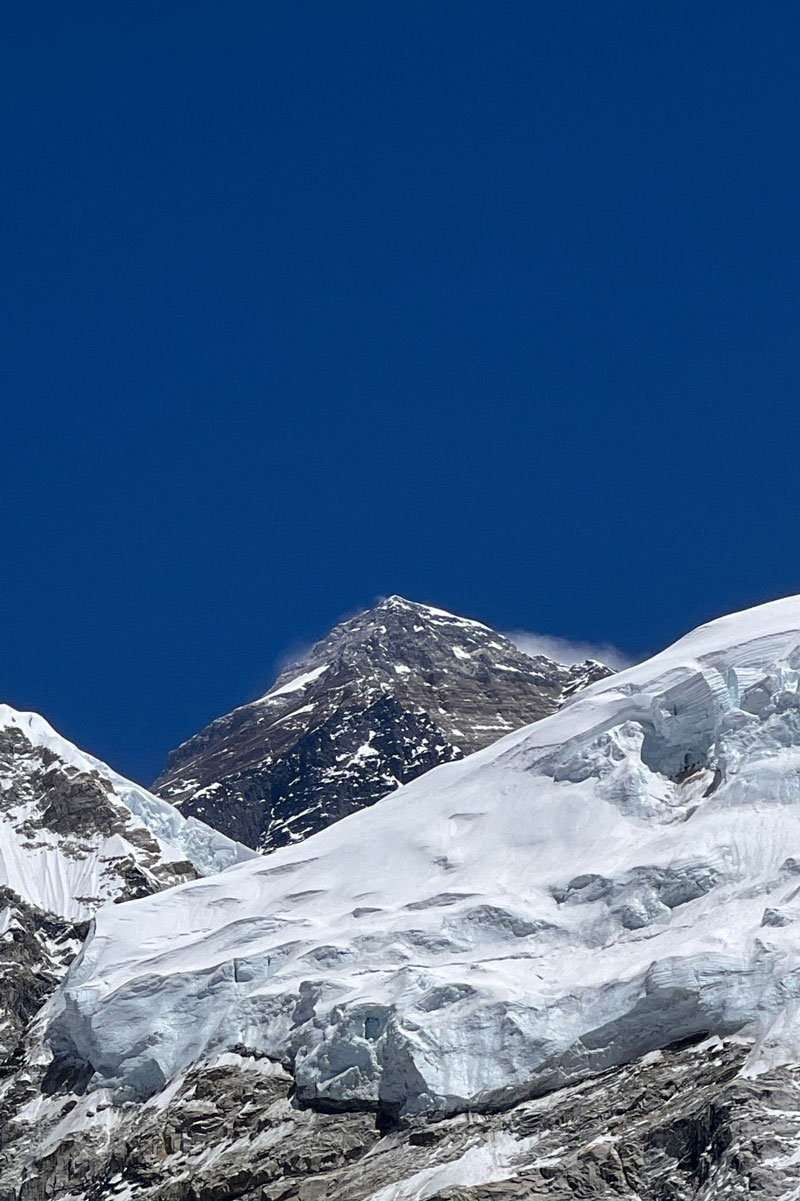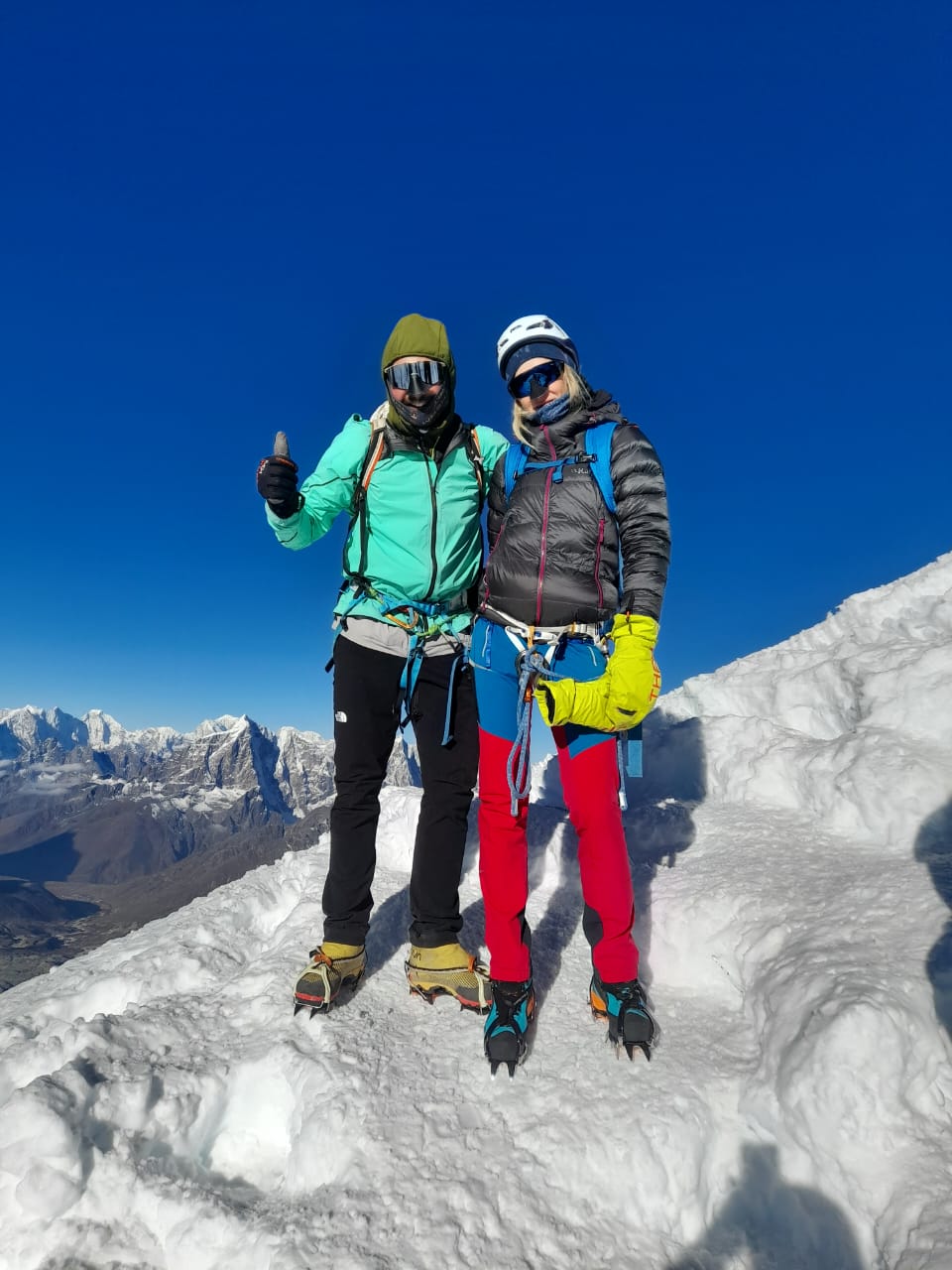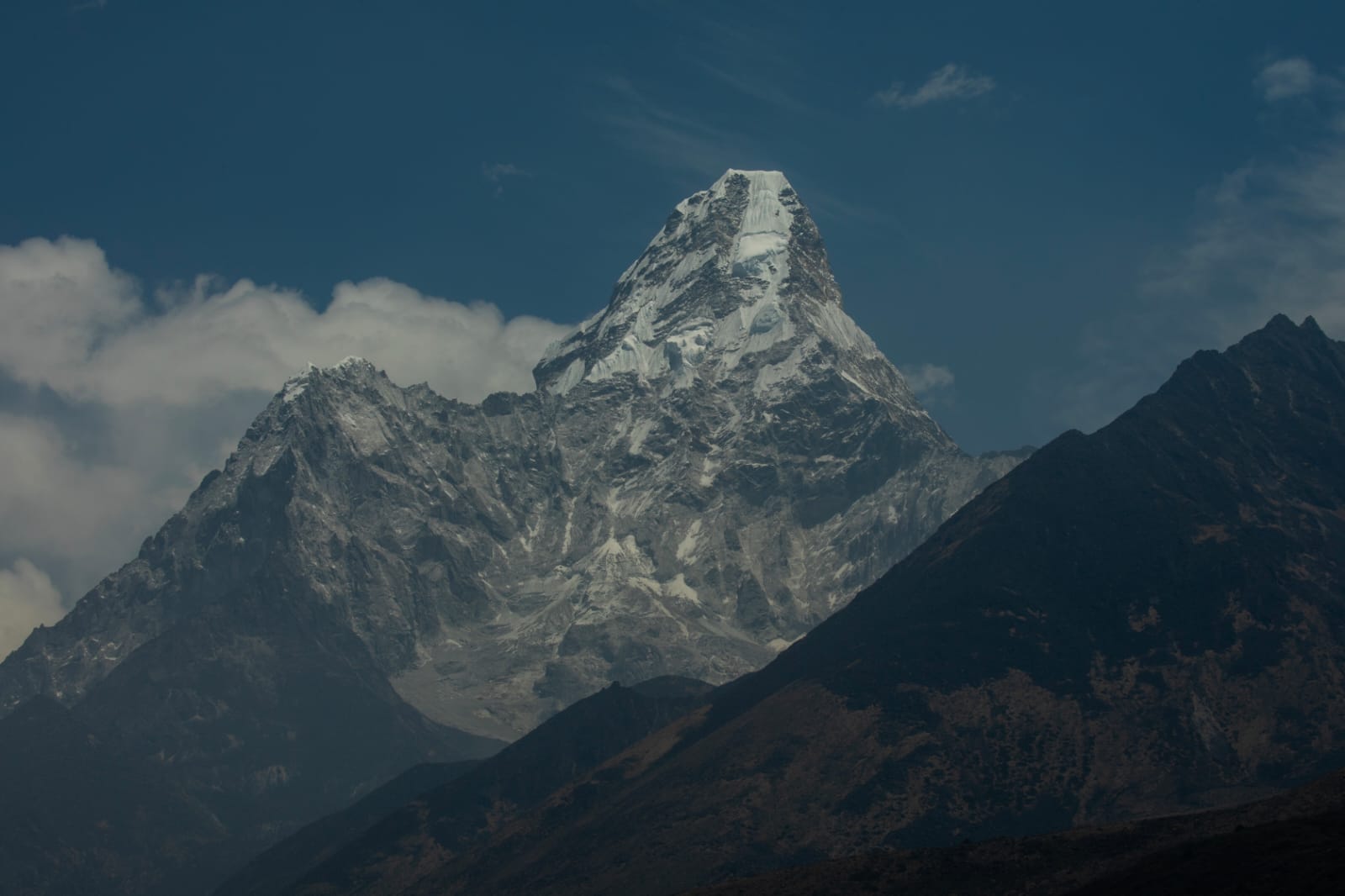Embark on the Great Himalayan Trail (GHT)
Imagine traversing one of the most breathtaking and adventurous trekking routes in the world—the Great Himalayan Trail (GHT). Stretching across the majestic Himalayan mountain range, this epic journey takes you through the heart of Nepal, India, Bhutan, and Tibet, challenging both your physical limits and immersing you in rich, vibrant cultures along the way.
Two Routes, Endless Adventures
The Peak15adventure’s GHT offers trekkers two unforgettable experiences:
– The High Route: For the adventurous spirit, this technically challenging path weaves through the highest and most remote areas of the Himalayas. Peak15adventure team advise to prepare to conquer rugged terrains and high-altitude passes that push you to your limits.
– The Lower Route: If you’re seeking breathtaking views without the extreme altitude, this accessible trail meanders through serene valleys, bustling villages, and lush forests, providing ample opportunities to connect with the local culture.
Explore the Diverse Geography of the GHT
While the GHT stretches across five countries, Nepal stands out as the most popular destination for trekkers, thanks to its stunning landscapes and welcoming trails.
– Nepal: Covering around 1,200 kilometers, this section spans from east to west, inviting adventurers through iconic regions like Annapurna, Dhaulagiri, Langtang, and the spectacular Everest area.
– India: Journey into the Indian states of Himachal Pradesh and Uttarakhand, where you’ll find captivating views of peaks like Nanda Devi, framed by the vibrant culture of the region.
– Bhutan: Immerse yourself in the unique enchantment of Bhutan’s eastern Himalayas, where you can explore sacred monasteries and breathtaking, less-traveled landscapes.
– Tibet: Finally, set your sights on Tibet, a less-frequented section that offers immense natural beauty, albeit with political and logistical challenges.
Cultural Treasures Await on the GHT
Peak15adventure prepare to be amazed by the rich tapestry of cultures you’ll encounter on your trek. In Nepal, you’ll meet diverse communities like the Sherpa, Tamang, Gurung, and many more, each sharing their unique traditions and languages. In Bhutan, the captivating Dzongkha culture and awe-inspiring fortresses will take your breath away, while in Tibet, the spirit of Tibetan Buddhism and the stark beauty of the Tibetan Plateau will leave a lasting impression.
Majestic Mountains and Awe-Inspiring Wildlife
The GHT leads you amidst some of the world’s highest peaks, including the Annapurnas, Kanchenjunga, and Dhaulagiri, where towering giants like Everest and Lhotse reign supreme. Each turn reveals valleys dotted with glaciers and adorned with snow-capped summits—a true paradise for mountain lovers.
As you travel, keep an eye out for the breathtaking wildlife residing in national parks and conservation areas like Langtang and Sagarmatha. You might spot elusive snow leopards, playful red pandas, or colorful pheasants soaring through the skies.
Conquer High Passes and Embrace the Challenge
The Peak15adventures team is ready to take thrill of the GHT lies in its high-altitude passes, some exceeding 5,000 meters (16,404 feet). Notable crossings like Tashi Labsta Pass(5,755m), Thorong La (5,416m), French Pass (5,360m), Sherpani Col(6,135m), Amphu Laptsa Pass(5,845m), Lumba Sumba Pass (5,178 m), Cho La (5,300m), Renjo La (5,240m,), Tilman Pass(5,308m), and Larke la(5,106m), demand determination and skill, while the stunning views make every effort worthwhile.
For those seeking a challenge, the High Route often requires technical abilities such as glacier navigation and rocky scrambles, demanding careful preparation and resilience. The Lower Route offers a gentler experience, yet remains a captivating adventure through rugged terrains.
Unforgettable Sections of the GHT (Nepal)
The Nepal section of the GHT beckons with its breathtaking beauty and diverse landscapes.
– Western Nepal (Far West) – Humla and Rara Lake: This off-the-beaten-path expedition invites you through charming remote villages and lush forests, culminating at Rara Lake, the largest in Nepal.
– Annapurna Region (Central Nepal): Here, the Lower Route enchants with its verdant Gurung villages and tranquil valleys, while the High Route reveals the rugged grandeur of Dhaulagiri Base Camp and majestic views of the Annapurnas.
– Langtang and Helambu Regions: Famous for its Tibetan-influenced culture and stunning alpine meadows, Langtang Valley beckons trekkers with panoramic vistas of peaks like Langtang Lirung (7,227m) and the mesmerizing Gosaikunda lakes.
– Exploring the Solukhumbu Region: The Gateway to Everest: Prepare to embark on an unforgettable journey through one of the most iconic regions of the Great Himalayan Trail (GHT) — the Solukhumbu. This area is home to the famed trek to Everest Base Camp, where every step offers breathtaking vistas of towering giants like Mount Everest, Lhotse, Makalu, and Nuptse.
As you navigate the mesmerizing Khumbu Valley, you’ll pass through lively Sherpa villages such as Namche Bazaar, Tengboche, and Pheriche, each rich with culture and hospitality. A must-visit is Kala Patthar, a vantage point that promises one of the most dazzling perspectives of Everest, especially at sunrise when the first light kisses the mountain’s peak.
– Journey to Kanchenjunga: Nature’s Hidden Gem: Venture east to the remote beauty of Kanchenjunga, one of the most biologically diverse areas in Nepal and home to the world’s third-highest mountain. The trek through this stunning section of the GHT leads you to Kanchenjunga Base Camp, a pivotal highlight that immerses you in the raw splendor of the Himalayas. Here, the views are nothing short of spectacular, showcasing the majestic peaks that tower above.
Navigating the GHT: What You Need to Know ?
Permits: A Trekker’s Essentials
Peak15adv believes that the trekking to the GHT isn’t just about packing your bags; it involves obtaining various permits, especially in national parks and conservation areas. Be prepared with your TIMS (Trekkers’ Information Management System), ACAP (Annapurna Conservation Area Permit), and the Sagarmatha National Park Permit for the Everest region. If you’re headed into restricted zones like Upper Dolpo, Upper Mustang or Kanchenjunga, remember to secure special permits in advance and Peak15adventure is official/legally registered company so our team will make ready all the require docs in the appropriate time and dates.
Timing Your Adventure
The ideal times to embark on the GHT trek are during the pre-monsoon (March to May) and post-monsoon (September to November) seasons. Avoiding the monsoon months (June to August) is wise due to heavy rainfall and potential landslides. Winter months (December to February) can bring harsh cold and snow, particularly at higher altitudes, making trekking hazardous.
Accommodation: Where to Rest Your Weary Feet
Along the trail, accommodation varies widely. In the busy circuits, you’ll find welcoming teahouses, while in more remote areas, basic camping is the norm. In high-altitude zones, expect fewer teahouses, so consider carrying your own camping gear for those nights under the stars.
Logistical Support: Guiding Your Journey
While some trekkers prefer to navigate solo, hiring guides and porters is highly recommended, especially for the more remote or challenging stretches. For the High Route, where technical skills come into play, experienced guides with mountaineering backgrounds can make a significant difference.
Challenges to Embrace
Peak15adventure team advise you to be aware of these following challenges as you set out on this epic journey, be mindful of the challenges that await:
– Altitude Sickness: The heights of the GHT can pose a risk of altitude sickness. Trekking at a measured pace and incorporating regular rest days will help you acclimatize.
– Remoteness: Many segments of the GHT are isolated, demanding self-sufficiency for extended periods. Resupply options are limited, so come prepared.
– Physical Endurance: This trek is not for the faint of heart. Prepare for several days of challenging trekking, often lasting 6-10 hours over rugged terrain.
Embarking on the GHT is not just a hike; it’s an adventure of a lifetime that immerses you in nature’s grandeur and tests your limits. Are you ready to take on the challenge with Peak15 Team?
Packing List
- Down Jacket (At Least for -10°C)
- Warm Fleece
- Windproof Gore Tex Jacket
- Trekking Boots (Ankle support boot is recommended)
- Flip Flops
- Sunglasses/Sun hat/Sun Cream
- Personal Medications
- Personal Toiletries
- Camera/Phone Chargers and Power Bank
- T-Shirt/Long Sleeve Tops
- Shorts/Trekking Pants
- Socks and Underwear
- Warm Hat or Beanie
- Rain Poncho
- Travel Towel
- Thermal Under Layers
- Headtorch
- Day Pack min 20-30 liters
- 2 Water Bottles or 2lt camel pack
- Warm Trekking Gloves (Warm Weather)
- Sleeping Bag
- Neck Gaiters
- Original Passport and Cash
Note: The Peak15Adventure team is proud to organize this epic journey, offering the finest accommodations and a once-in-a-lifetime experience in the heart of the Himalayas.
At a Glance
At a Glance
150 Days
6135m
Advanced
Apr
–
May
150 Days
6135m
Advanced
Apr
–
May
Key Highlights
Key Highlights
-
Embark on the Great Himalayan Trail (GHT)
-
Two Routes, Endless Adventures
-
Explore the Diverse Geography of the GHT
-
Cultural Treasures Await on the GHT
-
Majestic Mountains and Awe-Inspiring Wildlife
-
Conquer High Passes and Embrace the Challenge
-
Unforgettable Sections of the GHT (Nepal)
Departures
From
To
From
To
Journey to the Summit
Journey to the Highlights
Arrival in Kathmandu (1,400m)
As you step off the plane at Tribhuvan International Airport (TIA), prepare for an unforgettable journey! Our Peak15adventure’s representatives, along with your attentive driver and expert guide, will greet you with warm smiles and help you settle into the excitement. Buckle up for a quick ride through the vibrant streets of Kathmandu to your carefully chosen hotel, where hygiene, cleanliness, and hospitality are our top priorities.
Once you check in, take a moment to recharge with a brief thirty-minute recess before we dive into an exhilarating day of exploration. Get ready for a whirlwind of sightseeing, shopping, and indulging in a delightful welcome dinner—all designed to immerse you in the pulsating spirit of this captivating city.
Kathmandu can feel like a thrilling maze for first-time visitors, but don’t worry! As you explore, you’ll fall in love with its rich diversity and warm hospitality. Just remember to tread carefully in the bustling alleys and when crossing the roads, as the traffic here dances to a different rhythm. To enhance your experience, it’s wise to familiarize yourself with a bit of Kathmandu’s culture beforehand!
Sightseeing in Kathmandu
After a hearty breakfast, your guide and driver will be ready to whisk you away from your hotel for an unforgettable day filled with awe-inspiring sights. Prepare to marvel at the stunning Bhaktapur Durbar Square, the sacred Pashupatinath Temple, and the breathtaking Swayambhunath Temple—three of Nepal’s seven UNESCO World Heritage Sites!
At Bhaktapur Durbar Square, you’ll be transported back in time with its remarkable 12th-century architecture from the Malla Dynasty. Wander through stunning sites like the Vatsala Temple, the Golden Gate, and the majestic 55-Window Palace. Don’t miss the chance to savor Bhaktapur’s authentic Newari cuisine—a culinary adventure that’s as rich as the history surrounding you.
Next, visit Pashupatinath, a sacred temple dedicated to Lord Shiva and a hotspot for devotees and travelers alike. Explore the mystical Ghats, marvel at the intricate temples, and immerse yourself in the serene atmosphere of this revered site. Keep an eye out for the colorful Sadhus who populate the area!
Then, it’s off to Swayambhunath, famously known as the Monkey Temple! Perched atop a hill, this sacred site is a haven for both Hindus and Buddhists. As you climb, you’ll be greeted by mischievous monkeys and a stunning panoramic view of the valley below. Visit the Main Stupa, the charming Harati Temple, and many other hidden gems where spirituality and nature come together.
Your knowledgeable guide will share fascinating stories about each site, making every moment a treasure. A delicious lunch will be scheduled between explorations to keep your energy up. After a day full of discoveries, relax on the ride back to your hotel, where dinner arrangements will reflect your personal preferences.
Fly to Bhadrapur (2420m) and Drive to Phidim (Approx. 5 hrs. Drive)
Bhadrapur, located in the terai region of southeastern Nepal, offers an inviting beginning to our journey. The flight from Kathmandu takes approximately 50 minutes, providing stunning aerial views of varied trekking paths and the majestic Himalayas, ranging from Kanchenjunga in the east to Langtang in the west. Following our arrival, we travel northeast to Phidim, nestled within a breathtaking valley at the foothills of the Himalayas. This charming hill township captivates visitors with its enchanting vistas of the eastern Himalayas, making it an ideal stopping point. The drive to Phidim takes around 5 to 6 hours, where we spend the night in a comfortable hotel or lodge.
Drive to Chiruwa (1270m) (Approx. 8 hrs. Drive
The next day, our adventure continues as we drive towards Chiruwa via Taplejung. Chiruwa, resting within a spectacular Himalayan gorge, is surrounded by dense patches of sub-tropical rainforest and dramatic cliffs. The region is home to the Kirati people, known today as the Limbu, who have inhabited these lands for over 2000 years as subsistence farmers. During our visit, we can observe fields of rice, millet, barley, wheat, and corn flourishing along the landscape. This leg of our journey involves approximately 8 to 9 hours of driving, leading us to an overnight camp in the heart of nature.
Trek to Suketham (1640m) (Approx. 6 hrs. Trek)
Commencing our trek to Sukethum, we embark on a well-defined trail that promises an enjoyable and fulfilling experience. As we walk, we’ll notice subtle changes in the landscape, marked by gentle climbs that lead us into a captivating valley. We navigate through large boulders, passing beneath the village of Tapethok and carefully traversing a landslide area before reaching a bridge that spans a tributary of the Tamur River, known as the Simbuwa Khola, flowing from the southern slopes of Kanchenjunga. Continuing toward our base camp, we’ll cross several bridges and follow the now fabled Gunsa Khola, where we set up camp for the night.
Trek to Amjilosa (2390m) (Approx. 6 hrs. Trek)
On our journey, the trail narrows as we closely follow the winding Ghunsa River until we pause for lunch. This segment of our trek demands caution and focus, particularly as we encounter a small Sherpa settlement, where locals raise yaks. After lunch, a steep ascent awaits us as we make our way to Amjilosa, a quaint Tibetan settlement known for its picturesque charm.
Trek to Gyabla (2730m) (Approx. 6 hrs. Trek)
The walk today will take us deep into the heart of the forest, where we’ll be surrounded by towering trees and the soothing sounds of nature. As we meander along the path, we’ll encounter several stunning waterfalls, each cascading over rocks with a gentle roar, creating a mesmerizing spectacle. The absence of villages on our route enhances the sense of isolation, allowing us to fully immerse ourselves in the tranquil beauty of our surroundings. The air is crisp and fresh, filled with the earthy scent of damp moss and the sweet fragrance of wildflowers, enriching our experience as we explore this serene wilderness.
Trek to Ghunsa (3430m) (Approx. 6 hrs. Trek)
The subsequent day’s hike takes us predominantly through lush forests teeming with waterfalls, reinforcing the sense of seclusion enveloping us in serene surroundings. Before our midday break, we navigate a narrow trail through thick foliage, reaching Phole village for lunch. This Tibetan village serves as a winter settlement for the locals of Ghunsa, primarily reliant on yak herding and carpet weaving for their livelihoods. Here, we will encounter the only monastery throughout our trek, where visitors are welcomed to explore and engage with the local culture.
Acclimatization Hike to Ghunsa
Today is designated as a well-deserved rest day, allowing us downtime for personal chores like laundry or simply relaxing. Weather permitting, we might embark on a 3-hour exploratory walk along the banks of the Khanso Thanso River, revealing panoramic views of the heavenly Phole Peak, Sobithongi Peak, and glimpses of the towering Mt. Khumbakaran. After our strenuous days of trekking, this day of rest is not only beneficial but highly recommended.
Trek to Khangpachen (4040m) (Approx. 7 hrs. Trek)
As we ascend from Ghunsa, the signs of civilization diminish significantly, with only seasonal settlements inhabited by yak herders. These herders drive their animals to elevations of 4000m-4500m during the warmer months. The scenery unfolds magnificently along the route, showcasing the awe-inspiring cliffs and towering peaks of the Kanchenjunga massif and Jannu (7710m) that rise dramatically from the grand glacial valley. At times, the trail becomes ill-defined, requiring us to traverse loose scree and rocky stretches displaced from ancient glaciers. We typically set up camp at Kambachen (4200m), a location that is only seasonally occupied by locals. In this remote part of the Himalayas, we may come across diverse wildlife, including blue sheep, ibex, and mountain goats, as well as smaller creatures like hyrax and marmots among the rocks. Overhead, we may spot various birds of prey, including Lammergeir (a type of vulture), along with eagles, kites, and falcons soaring against the alpine sky.
Trek to Lhonak (4780m) (Approx. 6 hrs. Trek)
The next day presents yet another challenge requiring an early start. We begin our ascent along the lateral moraine, navigating for an hour before encountering a landslide area filled with large boulders that we must meticulously traverse. The trail then steepens as we climb to the top of the lateral moraine, where the pace eases for a while until we reach our destination—Lhonak.
Trek to Kanchenjunga Base Camp (Pang Pema) (5140m) (Approx. 5 hrs. Trek)
As we journey along the lateral moraine towards base camp, the mountain views are nothing short of spectacular. We gently climb for two hours, before crossing a steep section of loose rock, followed by another hour of gradual ascent that ultimately leads us to base camp. For those feeling ambitious, opportunities for rewarding side treks in the area may arise, further enhancing our breathtaking Himalayan adventure.
Retrace Back to Ghunsa
We undertake the journey back to Ghunsa, retracing our steps along the same scenic route. This return trek reveals a fresh perspective on the majestic mountain landscapes and breathtaking surroundings, each bend in the trail offering new vistas.
Rest and explore Ghunsa Village
Rest and explore Ghunsa Village
Trek to Nango La Camp (4776m) (Approx. 4 hrs. Trek)
Upon reaching Ghunsa, we begin our descent along the main path that follows the tranquil Ghunsa Kola river. The journey navigates through lush valleys and past gentle slopes, until we arrive at a significant junction in the trail. Here, we veer off the beaten path to ascend toward a series of idyllic summer grazing pastures, locally known as Khaka, where we’ll set up camp for the night under a blanket of stars.
Trek to Nango La Camp (4776m) (Approx. 4 hrs. Trek)
A pre-dawn start is essential for this leg of the expedition, as we aim for clear skies during our crossing of the Nango La pass. As we reach the summit of the pass, a striking bowl-shaped valley unfolds below us. We take the northern route along the river, weaving into a dense forest that leads us to the Yangma Kola, where we will pitch our camp for the evening.
Day 17 marks our trek to Olangchun Gola, a vital trade center that bridges the cultural and economic exchange between Nepal and Tibet. Here, we witness the flow of goods—Tibetan salt, carpets, and wool coming in exchange for Nepalese exports such as grain, sugar, cigarettes, and cotton thread, painting a vibrant picture of local trade life. Following a rest day in Olangchun Gola, we prepare to embark on the next stage of the journey.
Commence Sanku link of the GHT from Olangchung Gola to Pass Camp (4453m)
Commencing our ascent along the Sanku link of the Great Himalaya Trail (GHT), we transition from Olangchung Gola towards Pass Camp (4453m). This segment of the trek leads us into the rugged heart of the Lumbha Sambha wilderness, advancing into the Makalu region. We journey northward, crossing the Tamor Khola river and navigating up the Dingsamba Khola. The path climbs through enchanting rhododendron forests, revealing hidden valleys, each turn presenting us with awe-inspiring views.
Cross Lumbha SambhaLa to Thudam (3556m) (Approx 6 hrs.Trek)
As we ascend towards the crest of a saddle, the stunning granite peaks of Lumbha Sambha rise before us. The trail becomes faint and indistinct, often blanketed in snow, demanding careful movement. After traversing beneath a stark peak, we reach another saddle before making the crossing over Lumbha Sambha at 5159m. From this vantage point, the eastern panorama unfolds, revealing the lofty silhouettes of Jannu and Makalu. Descending from the pass, we veer northwest.
Trek to Chamtang (2187m)
En route to Chyamtang, the trail can be challenging to follow due to thick underbrush, adding an element of adventure to our hike. We descend to the Medokchheje Khola river before the route climbs once more, following the western fork. Certain stretches of the path require scrambling as we navigate the contours of ridges, eventually leading us to a small pass where we’ll establish a cozy camp for the night. The next day, we tackle another minor pass before making our way down to cross the Arun Nadi river, arriving at the welcoming Lhomi village of Chyamtang, where we will rest and recharge.
Trek to Hongon (2323m) (Approx. 6 hrs.)
Once back on the main trail, the path to Hongon is relatively easy, signaling our departure from the Kanchenjunga region as we transition into the next leg of the GHT, which leads us toward Makalu.
Trek to Bakim Kharka/ High Camp (3020m) (Approx. 4 hrs.)
Today presents a short yet demanding hike with steep ridge climbs and a minor pass at 2710m.
Day 28-34: Trek to Molun Pokhari (3954m) (Approx. 6 hrs), Dhunge Kharka (2980m) (Approx. 8 hrs), Saldim Khola or Cave Camp (3900m) (Approx. 7 hrs, Adventure Pass Camp (3900m) (Approx. 5 hrs), Kalo Pokhari (4100m) (Approx. 7 hrs), Grazing Kharka (3960m) (Approx. 7 hrs)
For the following seven days, we trek through the remarkable landscapes of Makalu Barun National Park. Here, the trail morphs into a mix of steep, rocky pathways interspersed with sections requiring some scrambling and challenging climbs. We skirt around the picturesque Molun Pokhari lake, navigating southward while crossing rivers, sometimes relying on logs to traverse, and penetrating the thick, fragrant rhododendron forests. These segments of the journey test our endurance as we traverse areas less frequented by other trekkers, often finding limited options for camping.
Trek to Yangla Kharka (3557m), (Approx. 5 hrs and Rest Day)
Eventually, we descend into the valley’s floor, where the easier main trail guides us toward the Makalu Base Camp and Yangla Kharka. Towering rock formations embrace us as we traverse this expansive U-shaped valley, known for its spectacular vistas and often likened to the Yosemite of the Himalayas. This stunning locale invites us to join our fellow trekkers arriving from Tumlingtar.
Trek to Langmale Kharka (4400m) (Approx. 5 hrs) & Rest Day
Today is a short trekking day to Langmale Kharka to help with our acclimatization. As we journey through this area, we are surrounded by impressive mountain scenery. Towering rock walls rise above us as we traverse the vast U-shaped valley. The snowy peaks provide a stunning backdrop, making this valley often referred to as the Yosemite of the Himalayas. It is a magnificent location to enjoy a well-deserved rest day.
Trek to Makalu Base Camp (4870m/4hrs), Rest Day
At Makalu Base Camp, the views of the south face of Makalu are nothing short of breathtaking. The south buttress provides an impressive backdrop featuring Baruntse (7220m), Everest, and Lhotse. The traditional climbing base camps, namely Hillary and French base camps, are situated further up the glacier, beyond Barun Pokhari, frequently utilized by climbing expeditions targeting Makalu. An optional, rewarding excursion leads us from Base Camp up grassy slopes to the ridge, where, at 5250m, we can enjoy an unparalleled view of Everest, Lhotse, Lhotse Shar, the intricate north and southeast ridges of Everest, alongside the dramatic Kangshung Face and the South Col, with Makalu towering above us to the north
Trek to Swiss Base Camp (5150m/4-5 hrs)
The trek to Swisse Base Camp involves navigating a tricky route that demands boulder hopping as we follow the Barun Glacier directly beneath Makalu imposing west face. Swisse Base Camp is nestled among the moraines in a sandy enclave directly opposite the formidable West Pillar of Makalu. Campsites in proximity to these majestic 8000m peaks are scarce, making this stop a rare and special experience. We dedicate a full day to rest and acclimatize, hoping to climb to a vantage point above our camp, weather permitting, to gain a spectacular view of Everest and the mythical Kangshung Face.
Trek to Sherpani Col Base Camp (5700m/5-6 hrs), cross Sherpani Col (6180m) to Baruntse High Camp (West Col at 6100m), walk approx. (Approx. 7 hrs. Trek)
To prepare for our crossings of the Sherpani and West Cols, we’ve allowed for two days of flexible planning in case we need to adjust our strategies based on group dynamics and progress. As we approach the base camp for Sherpani Col, the trail becomes less defined, requiring careful navigation through rocky terrain, with boulder hopping becoming a necessity. Climbing higher into the atmosphere, we may encounter areas of obscured visibility due to weather conditions. Our camp is set high at the glacier’s snout, at 5688m, with the Sherpani Col looming just three hours above us. Should conditions remain favorable and our group maintain a steady pace, we anticipate making our attempt to cross the Sherpani Col soon.
Cross WestCol to Honku Basin & Amphu Labtsa Base (5400m)
After our crossings are completed, we descend into the enchanting Honku Valley, where five majestic glacial lakes shimmer beneath the sun, sprawling out before us like a breathtaking mosaic. Known as Panch Pokhari (the Five Lakes), these serene bodies of water reflect the surrounding peaks and the captivating sky. To our right, the Amphu Labtsa Pass looms, perched at the head of the valley—this low point on the ridge marks the boundary between the tranquil Honku and the Imja valleys. For a day or so, we immerse ourselves in the beauty of the Honku, where a stunning vista of towering peaks unfolds, including the iconic Ama Dablam to the distant west, alongside many unnamed summits waiting to be explored. At Amphu Labtsa Base Camp, we find ourselves nestled close to the rugged rocks that serve as a pathway to the daunting pass.
During these stages, we ask for flexibility and cooperation from all members, as camp locations will be determined by prevailing conditions. Your leader will keep everyone informed about the day’s plans, ensuring a smooth journey.
Cross Amphu Labtsa (5845m) to Chukung (4730m) (Approx. 9 hrs.)
An alpine start marks the day of our pass crossing, as we gather to ferry our loads together with all party members, crew, and porters—a process that takes some time. The approach to the pass from Honku is deceptive; as we face the east and south, sunshine bathes us in warmth, revealing a landscape scattered with rocks that gradually lead us to the gap we seek. However, on the north-facing slopes, steep stretches of pristine snow demand our careful descent via fixed ropes to the inviting snow basins below, followed by the moraine and alpine valley that awaits. The panoramic views from this lofty 5,845-meter pass are simply unmatched, offering glimpses of the grand peaks of Khumbu that stir our spirits. Each spare moment during our climb and descent allows us to revel in the spectacular beauty surrounding us.
Trek to Dingboche (4360m/4hrs), Dzongla (4843m/3hrs)
Day 23 leads us to the charming village of Dingboche, where our comfortable private campsite awaits. Over the past week, we have navigated some of the most challenging terrain in the Himalayas. From our camp, we are treated to excellent views of the towering mountains Nuptse, Lhotse, Chukung Peak, and Imja Tse (6,189m), all framed by the dramatic glacial landscape. Massive glaciers cascade beneath sheer cliffs that rise dramatically to nearly 3,500 meters, creating a breathtaking tableau. The next day, we journey to Dzongla, another remarkably situated camp, as we continue our ascent towards the next challenge, the Cho La Pass.
Cross Cho La to Gokyo (4759m) (Approx 6 hrs)
As we awake to another magnificent day, we leave behind the familiar Everest watershed and enter the majestic realm of Cho Oyu, the sixth highest mountain in the world. The crossing involves a steep scramble up rock boulders, followed by a gentle walk across a snow-covered glacier that blankets the pass. The views of the route ahead and the glacier itself are nothing short of breathtaking. We must then descend steep, boulder-strewn slopes into the spectacular Gokyo Valley, a paradise of turquoise lakes and sweeping glaciers. Initially, discernible paths zigzag down the mountainside, though they can be treacherous when coated in snow. As the ground levels out, the path fades away entirely, challenging us to navigate a field of boulders. Eventually, we climb a gentle slope that leads to the summit, from which it’s all downhill, following a narrow river valley to its base at Dragnag, a quaint Sherpa settlement nestled beneath towering rock walls, just a stone’s throw from the colossal Ngozumpa Glacier. We arrive in Gokyo by late afternoon, greeted by its stunning vistas.
At Gokyo, ascend Gokyo Ri (5483m)
The steady and relentless ascent of Gokyo Ri will take around two hours, but the exhilaration of reaching the summit is unmatched, rewarding us with a spectacular viewpoint. Many believe it offers the most comprehensive view of the 8,000-meter peaks in Nepal, including a dramatic sight of Cho Oyu (8,153m), which famously thwarted a British expedition, including Hillary, on their way to Everest. Other giants surround us, including Gyangchung Kang (7,922m), Lhotse (8,501m), Makalu (8,475m), Cholatse (6,440m), Taweche (6,542m), Kantega (6,685m), Thamserku (6,808m), Lobuche (6,145m), and the mighty Mt Everest (8,848m). Hundreds of other unnamed peaks fill the horizon, while below us, the Ngozumba Glacier—the largest in Nepal—stretches through the valley, its striking turquoise lakes completing this awe-inspiring tableau. The only way to attain a better view of the entire Everest region would be to ascend an 8,000-meter peak! Though further from Everest than Kala Pattar, the traditional viewing point, here we can appreciate the mountain’s majesty while enjoying a calmer atmosphere for our reflections.
Cross Renjo La (5400m) to Lungden (Approx. 7 hours)
As we cross the Renjo La Pass, we navigate a zigzag path through boulders to reach the summit at approximately 5,360 meters. The initial descent is steep, plunging into a remote northern valley where the scenery gradually shifts to resemble the Tibetan landscapes beyond the border. This ancient trading route has long been traversed by Tibetan traders making their way from the Nangpa La Pass. We will spend the night in Lungden, resting from our journey.
Trek to Thame (3820m/3hrs)
Our route then turns south, winding down the valley towards Lukla for our return to Kathmandu. Along the way, we’ll explore vibrant Sherpa villages as we descend the gorge, spending a night in the picturesque village of Thame, known for its stunning monastery. Here, we part ways with the Makalu team while we continue our adventure with the Rolwaling team, enjoying a well-earned rest day in the tranquil village of Thame.
Trek to Parchemuche Tsho (4780m/ 6.5hrs) & Cave Camp (5665m/ 5.5hrs)
We will dedicate two days to our approach to the Tashi Labsta. Our first night is spent by the beautiful lake, Parchemuche Tsho, which offers a picturesque setting. During this time, we will monitor the weather conditions closely, preparing for the impending pass crossing that lies ahead. Our cave camp is strategically positioned high up, ensuring we are well-placed for the journey to come.
Cross Tashi Labsta (5760m) to Trakarding Glacier (4735m) (Approx. 7 hrs) and Yak Kharka (Approx 7 hrs.)
The weather, along with snow and glacier conditions, will significantly influence the challenge of our route. We embark on a steady ascent through a series of enchanting rock and ice gullies, ultimately reaching a breathtaking pass that reveals an awe-inspiring panorama of majestic mountains. Many of these peaks remain untouched, lacking formal names, and feature one of the most elusive regions of the Nepal Himalaya. Towering above us are Tengi Ragi Tau and Pachermo, their dramatic profiles defined by sheer ice and rock faces that captivate the eye. Notably, Pachermo was successfully submitted by a group of World Expeditions climbers during a 2022 expedition.
Our journey ahead involves a long, gradual trek across rocky terrain and snow, leading us down challenging, crevassed slopes to the Trakarding glacier. Portions of the route typically require some scrambling over both rock and ice, and when necessary, we will secure a rope to serve as a handrail for added safety. Our dedicated staff will collaborate closely with team members, ensuring a safe and secure passage for everyone. Upon reaching the pass, we will relish the thrill of our surroundings, nestled between two magnificent mountain ranges. We will establish our overnight camp on the sprawling Trakarding glacier, soaking in the tranquility of this remote wilderness. The following day, we will continue on our journey to Yak Kharka, where we will set up our next camp.
Trek to Beding (3740m/ 5 hrs). and onto Kyaise (5-6 hrs)
Descending into a warmer climate, the stages to Beding are decidedly pleasant as we navigate through lush rhododendron, pine, and juniper forests while strolling alongside flowing rivers. Birdsong fills the air, inviting us deeper into this vibrant ecosystem. On the following day, our trek leads us to our camp at Kyaise.
Trek to Chetchet (1400m/ 5.5hrs) & Bulung (1900m/ 8-9 hrs).
As we descend further into the green embrace of nature, the trek becomes increasingly effortless, especially now that we are fit and fully acclimatized. We will spend the night in Chetchet. The next leg of our journey takes us through thick forests, where we will pass cascading waterfalls on our way to the village of Bulung. The landscape around Bulung is adorned with expansive terraces of wheat, barley, and millet, where locals diligently tend to their fields and livestock, making a living in harmony with the land.
Trek down valley to Sano Jynamdan
Over the next three days, we will trek toward our exit point at the Last Resort Village. Our path will lead us to Pakhola, where we will walk for 6 to 7 hours, followed by an additional 7 to 8 hours on the following day as we continue to Thisangla. A contingency day has been allocated, allowing us flexibility as needed. Our final day’s walk will take us to Sano Jynamdan, a journey of about 7 hours.
Walk to the Last Resort, Drive to Kathmandu (1330m)
On our last morning, we will complete the final 4-hour trek to The Last Resort, where our vehicles await. After transferring by road for approximately 5 hours, we will return to Kathmandu and the Barahi Hotel or 4 star category hotel for a well-deserved 2-day rest and relaxation period. Despite the ample acclimatization and well-timed rest days built into the Great Himalaya Trail (GHT) itinerary, an expedition encompassing 145 days of nearly continuous trekking is undeniably rigorous and taxing for the body. Therefore, these recuperation days are essential for successfully completing the GHT challenge.
Resume GHT, Langtang link. Trek to Listi (2260m) (Approx. 4 hrs. Trek)
Departing from the Last Resort, we will trek toward Listi. The trail climbs steeply up a hillside, offering invigorating views as we ascend to Baldun before continuing on to Listi, where a serene Hindu Temple perched on the ridge above beckons.
Trek to Bagam (2705m/ 4-5 hrs)
Leaving Listi behind, we will ascend along a picturesque ridgeline, traversing the enchanting hillside to reach the welcoming Sherpa village of Bagam.
Trek to Kyangsin (2520m/ 7-8 hrs), & Dipu (7-8 hrs)
We have several days of descent ahead as we progress towards Kyangsin and then onto Dipu, before starting our ascent to Kharka, ultimately making our way to Panch Pokhari.
Trek to Kharka (3600m/ 6-7 hrs)
As we progress along the ridge, the breathtaking panorama unfolds, revealing the majestic mountains that stretch east and west, creating a natural border with Tibet. In 1949, W.H. Tilman became the first European to explore this remote region, and since then, only a handful of adventurers have retraced his remarkable journey.
Trek to Panch Pokhari (4074m/ 3-4hrs), & Rest Day
Panch Pokhari, adorned with five sacred ponds, becomes a vibrant pilgrimage site as thousands of devotees ascend to its hallowed lakes during the monsoon season. Nestled here is the revered Mahadev Temple, and from this lofty vantage point, we are treated to stunning views of the Jugal Himal and Rolwaling ranges. We will pause for a well-deserved rest day here,
Trek to Intermediate Camp (4-5 hrs) & on to Tin Pokhari (4255m/ 6 hrs)
We now find ourselves well above the treeline, embarking on a brief ascent from Panch Pokhari to the ridgeline. Our route takes us northward, where we traverse spurs and gentle basins before descending into a picturesque valley that leads to a final climb to Tin Pokhari.
South High Camp (5-6 hrs) & Cross Tilman Pass (5308m) to north high camp (4720m/ 7 hrs)
As we approach the lower rocky section of the pass, we may encounter two different routes, our choice dictated by the ever-changing conditions. This challenging pass presents its own set of trials—loose rock and treacherous scree demand careful navigation. After scaling an imposing steep rock face at the beginning of our ascent, we traverse to the left, ultimately climbing onto the snowfield that marks the pass. Nestled to the northwest of this snowy expanse, we will then descend a steep slope, navigating the rocky gullies that require extra caution, as they can often be icy. Depending on conditions, our leader may decide to fix a handline to ensure safety during this strenuous crossing, which will last approximately 7 to 9 hours. Tonight, we will camp on the tranquil northern shore of a shimmering lake.
Trek to Kyanjin Gompa (3830m) (Approx. 7 hrs.)
Our journey now leads us closer to the famed Langtang Trail, where Kyangjin Gompa beckons with its inviting teahouses. Just nearby lies a fascinating cheese factory awaiting our visit, alongside the serene Gompa itself. If time permits, a rewarding hike to the viewpoint crowning a hill north of Kyangjin Gompa, adorned with fluttering prayer flags, offers an epic landscape worth the effort.
Trek to Lama Hotel (2490m/7 hrs) & Syabru Besi (1503m/ 6 hrs)
We seamlessly transition onto the clearly marked main trail of the Langtang trek. Following the gentle flow of the river, we meander past numerous teahouses and quaint villages, eventually reaching the bustling hub of Syabru Besi.
Ganesh Link to Gatlang (2238m) (Approx. 4.5hrs.)
Continuing onward, we connect with the Ganesh link of the Great Himalayan Trail (GHT) as we make our way toward the iconic Manaslu and Annapurna regions.
Trek to Somdang (3258m/ 6 hrs) & Tipling (1890m/ 7 hrs)
Departing from Gatlang, we delve into a world of lush pine and rhododendron forests, ascending gradually until we crest 3100 meters, where a sprawling kharka and camping area await. From here, we merge with a nearby road, traversing steep hillsides leading us to another kharka. A narrow trail guides us over the Khurpu Dada Pass at 3710 meters, followed by a westward descent into the quaint hamlet of Somdang. The next day, we continue our descent through thick rhododendron forests and terraced fields, making our way to the charming village of Tipling.
Trek to Lapa Khola (1258m/ 5.5hrs), Nauban Kharka (2750m/ 7 hrs), & Kerauja (2074m/ 7 hrs)
The subsequent three days take us deeper into the heart of nature as we trek through dense woodlands, climbing to gentle ridges and then descending into open basins.
Trek to Khorla Besi (970m) & Yaru (1100m) (Approx. 6-7 hrs.)
Today presents a relatively long trek as we merge with our GHT Manaslu and Annapurna trek at Khorla Besi. We are nearing the end of the Full Traverse, and our cooks may surprise us with a special celebratory meal tonight, marking our shared accomplishment!
Trek to Lama Chautara (1570m) (Approx. 5 hrs.)
On this day, we’ll encounter a series of pleasant ups and downs as we follow the river upstream, crossing several tributaries before finally arriving at our campsite in Lama Chautara
Trek to Bihi Phedi (1860m) (Approx. 5 hrs.)
As we continue our journey, there are moments when we must navigate high above the river to avoid narrow gorges that block our path. The trail guides us through verdant pine forests interspersed with vibrant rhododendron blooms. Eventually, we make our way to the lower trail, which follows the Budhi Gandaki River beneath the charming Gurung village of Ngak, before camping past Deng at Bihi Phedi.
Trek to Namrung (2630m) (Approx. 7 hrs.)
Ascending initially, we then descend to cross a swaying suspension bridge, arriving at the opposite bank where we face more undulating riverside trails. As we continue along, mani walls and chortens emerge, signaling our entry into distinctly Tibetan territory. Sticking to the northern bank of the Budhi Gandakhi, we are treated to glimpses of the towering Shringi Himal before reaching the predominantly Tibetan village of Ghap for lunch. Our trek resumes through lush forests, densely populated with pine and birch, guiding us to a scheduled jungle campsite just before Namrung.
Trek to Shyala (3520m) (Approx. 7 hrs) & Rest Day
We begin our day by descending to cross the Damonan Khola before ascending once more along a narrow forest path leading to Namrung, where a check post awaits our arrival. Our journey brings us closer to small Tibetan villages, and it is likely we will catch sight of our first yak today, alongside a lively troop of monkeys that often venture down to the river to drink. Throughout the day, sweeping views of Ganesh III and IV, as well as Boudha Peak, fill our vision, and to our right, the imposing Kutang Himal stands tall, marking the natural boundary between Nepal and Tibet. Most excitingly, before us, the true mountain panorama unveils itself, featuring the breathtaking peaks of Himalchuli (7893m), Peak 29 (7871m), and culminating with the majestic Manaslu (8163m). The following day, we will indulge in a well-deserved rest day at our campsite in Shyala.
Trek to Larkye Bazaar (4000m) (Approx. 7 hrs.)
Soon, we arrive at the Tibetan Refugee village of Samdo, an enchanting settlement home to about 200 permanent residents. This vibrant community, steeped in Tibetan culture, offers a glimpse into a way of life that thrives in harmony with the surrounding nature. The rustic yet colorful homes, adorned with traditional prayer flags, reflect the rich heritage of its inhabitants.
After soaking in the charm of Samdo, we continue our journey down to the banks of the Budhi Gandaki River. The sound of rushing water accompanies us as we traverse a quaint wooden bridge, which connects us to the next leg of our adventure. On the other side lies the fabled Larkye Bazaar, a lively hub where local traders gather, and the vibrant exchange of goods and stories comes to life.
Trek to Larkya Base Camp (4460m) (Approx. 4 hrs.)
After navigating a couple of gentle stream crossings, the majestic Larkye Glacier rises elegantly on the opposite bank, its icy façade glinting in the sunlight. We embark on a steady ascent, carefully skirting around the Sarka Khola. Our camp for the night is set at a quaint brick hut nestled at the base of the towering Larkya La, a pass that beckons with promise.
Cross Larkya La (5140m) to Bimthang (3590m) (Approx. 9 hrs.)
Not long into our journey, the distinctive silhouette of Larkya Peak comes into view, standing proud against the sky. The trail gently spirals upward, allowing us to acclimatize to the altitude. It takes us around five hours to reach the pass, with the final section presenting a challenging steepness that tests our resolve. However, every drop of sweat is rewarded by the breathtaking panorama that unfolds before us—the majestic Himlung Himal (7126m), the rugged Chap Himal, the stoic Gyaji Kang, the formidable Kang Guru (6981m), and the towering Annapurna II (7937m) all proudly display their glory. The descent from the Pass is a thrilling venture, steep and treacherous, winding down across patches of ice and loose scree as we trace the glacier’s path. Each step is deliberate and cautious, for the terrain demands our utmost respect. Eventually, we find ourselves descending into the verdant valley of the Burdin Khola, where we continue our trek toward Bimthang, our campsite for the night.
Trek to Dharapani (1865m) (Approx. 7 hrs.)
As we trek further, the trail meanders alongside the tranquil Marsyangdi River, its soothing gurgle providing a melodic background. Soon, we enter a pristine forest laden with pine and rhododendron. During the vibrant spring months, this woodland bursts into a kaleidoscope of colors, creating a stunning spectacle that begs to be captured—so don’t forget to stock up on film for our cameras; the views of both the Himlung and Manaslu Himal continue to leave us in awe.
Trek to Dharapani (1865m) (Approx. 7 hrs.)
As we trek further, the trail meanders alongside the tranquil Marsyangdi River, its soothing gurgle providing a melodic background. Soon, we enter a pristine forest laden with pine and rhododendron. During the vibrant spring months, this woodland bursts into a kaleidoscope of colors, creating a stunning spectacle that begs to be captured—so don’t forget to stock up on film for our cameras; the views of both the Himlung and Manaslu Himal continue to leave us in awe.
Trek to Koto (2620m) (Approx. 7 hrs.)
As we make our way onward, we shift from the enchanting Manaslu region into the equally captivating Annapurna region. The trail today winds over steep forest ridges, leading us across the river before finally arriving at Koto. We pass numerous mani walls adorned with intricately carved Mayu Prayer wheels, a hallmark of the villages that dot this landscape. As we round a bend, the breathtaking Paungda Danda rock face comes into view—a formidable, curved slab of rock soaring over 1500 meters from the river, a testament to nature’s artistry. In addition, glimpses of Annapurna II to the south and Pisang Peak to the northeast captivate our senses. Today marks a significant milestone in our journey—day 100!
Trek to Pisang (2675m/ 6-7 hrs) & Bhraka (3475m/ 6-7 hrs)
Continuing along the traditional Annapurna Circuit, we finally arrive in Pisang, a charming cluster of houses perched with the main village situated about 150 meters uphill. On day 102, we embark on a gentle ascent towards Manang’s airstrip at Hongde. Our campsite in Bhraka is a mere 40-minute walk from here and is one of the most picturesque spots of our adventure, offering breathtaking views of Annapurna 4 and 3, creating a perfect backdrop.
Trek to Yak Kharka (4050m) (Approx. 6 hrs.)
What a spectacular day it has been! After a hearty breakfast, we set off, winding around contours that bring forth ever more impressive views of Annapurna 3 and Gangapurna. Finally, we reach the serene Josang Valley, where our camp at Yak Kharka awaits, a fittingly beautiful end to another unforgettable day in the mountains.
Trek to Thorong High Camp (4700m) (Approx. 4 hrs.)
The day began with a brisk chill in the air as we embarked on a short but strenuous trek up the valley, crossing the Jorsang Khola on a quaint cantilever bridge. The landscape around us was rugged and wild, with loose scree slopes that demanded careful navigation. As we continued, the foot of the magnificent Thorong La emerged, marked by a couple of ramshackle tea shops, offering a much-appreciated respite for weary trekkers. As dusk settled in, we all agreed on the importance of an early night’s rest, for tomorrow promised to be a grand adventure.
Cross Thorong La (5380m) to Muktinath (Approx. 9 hrs.) & Rest Day.
Our journey took a transformative turn the next day as we set off from Phedi just before dawn, the sky painted with the soft hues of early light. Our goal was to summit the pass before the sun reached its zenith, evading the famous but fierce Thorong winds. The initial stretch of the climb was steep, and progress was slow as we navigated a trail riddled with endless switchbacks. Each false summit teased us, revealing yet another ridge to conquer. But at last, we were met with the sight of a colossal cairn adorned with fluttering prayer flags—the summit of the Thorong La. From this vantage point, the panoramic views of the Annapurna Range and the distant peaks of Mustang and western Tibet were nothing short of breathtaking, the vast expanse eliciting feelings of awe. The biting cold of the altitude urged us onward, descending toward Muktinath. Exhausted but exhilarated, our group of trekkers collapsed into our sleeping bags that night, each of us carrying the weight of the day’s unmatched Himalayan highs.
To Goat Kharka via Kagbeni (2810m), walk approx. 6hrs.
As we entered the breathtaking Kali Gandaki valley, we took a shortcut to evade the busy road leading to Kagbeni. This village, once a significant marker of the Nepal/Tibet border and now the official gateway to the Mustang region, whispered tales of history. The charming streets, lined with ancient structures, led us to the old Gompa and the remnants of a once-majestic fort at the village’s northern edge. Continuing our journey, we wound through Kharka and eventually into the enchanting, remote area of Dolpo. Here, nestled west of the upper Kali Gandaki at around 4000 meters, lies a land sculpted by towering peaks exceeding 6000 meters, home to the resilient Dolpo people. Unlike other communities, they lack a tribal or district name, with 25 to 30 villages spreading across 1300 square kilometers. These hospitable souls cultivate their own crops and herd yaks, sheep, and goats, all within stone houses that huddle together for warmth, resembling forts against the harsh environment. The stunning women of Dolpo adorn themselves in traditional garb, sporting striking headdresses of brass, coral, and turquoise—symbols of wealth and culture. While they follow Buddhism and Bon, their traditions resonate through the landscape, whether in the farming fields or the rugged trails that were immortalized in the 1998 film ‘Caravan,’ also known as ‘Himalaya.’
Trek to Santa (3778m) (Approx. 7 hrs.)
The challenges continued as we prepared for a demanding day ahead, crossing two formidable passes en route to Santa. We set out early, climbing a steep hillside into a gully that led us past shadowy caves and across a crisp watercourse. The main trail soon appeared once more from Phalyak, guiding us to our first pass at 4306 meters. Pressing onward, we traversed lush basins before conquering the Bhima Lojun La, rising to 4460 meters. For the next hour or two, we followed a delicate ridge before descending into a vast ravine, carefully navigating scree slopes until we finally reached Santa.
Trek to Ghalden Ghuldun Khola (4247m) (Approx. 6 hrs.)
Continuing our trek, we meandered through a series of gullies before ascending a demanding set of switchbacks to Jhansye, perched at 4195 meters. The trail leveled out as we crossed a hillside, leading us down to the Kyalunpa Khola. Here, a narrow wooden bridge beckoned us across, guiding the way to a steep gully that would lead us to a picturesque campsite nestled among juniper trees.
Trek to Lalinawar Khola (4800m/ 4hrs). Cross Jungben La (5550m) & Niwas La (5120m) to Nulungsunda Kharka (4987m/ 7 hrs) & Chharka Bhot (4302m/ 4-5 hrs)
In the subsequent days, our adventure demanded fortitude as we prepared for two challenging pass crossings above 5000 meters. Reaching the top of the Jungben La, we were greeted with breathtaking vistas of the Hidden Valley and the towering Dhaulagiri in the distance. The following day, the Niwas La awaited us, and after a gentle descent, we reached Nulungsumda Kharka, where we camped at the confluence of the clear Malun and Thasan Kholas. The trek to Chharka Bhot unfolded as a pleasantly easy day, allowing us to soak in the dramatic beauty surrounding us.
Treko Chap Chu (4320m/ 7 hrs), Maran (4350m/ 8 hrs), and Tungyalaphu (4450m/ 7 hrs)
Departing from Chharka Bhot, we followed the Chharka Tulsi Khola, its waters gurgling as we navigated a series of crossings that required us to dance back and forth along the riverbanks. Our path then ascended slightly before descending to a minor tributary, where we carefully leapt across stepping stones. Another steep climb of about 45 minutes brought us to Chap Chu, where we would settle in for the night. The following day promised another exhilarating adventure as we faced the crossing of Chan La at 5378 meters—our fitness and acclimatization rewarded us with an easy ascent to the pass. The views unfolded spectacularly before us, showcasing the grandeur of the surrounding peaks. We descended through a series of switchbacks to the valley below, eventually ascending to a ridge overlooking the Sheru Khola to the south. After passing a chorten, we trekked down to the Tarpi Khola valley, making our way toward Maran, a town steeped in history and tradition. Just an hour from Maran lies the vibrant trading village of Dho Tarap, where the spirit of the Dolpo people continues to thrive.
Cross Jyanta La (5100m) to Darsumanadobhan (4700m/ 6 hrs), Saldang (3770m/ 7 hrs), Shey Gompa (4345m/ 7 hrs)
We embark on a thrilling journey over the Jyanta La, arriving at a serene, flat grassy campsite nestled in the lush expanse of Darsumanadobhan. The following day, we begin our descent to Saldang, the vibrant administrative capital of Upper Dolpo, where the rustic charm of local life awaits us. Our adventure continues as we set off towards the revered Shey Gompa, passing through the quaint village of Namgung. Recognized as one of the most sacred sites in Dolpo, Shey Gompa offers a spiritual refuge, and if time permits, we may venture to the serene hermitage of Tsaking, perched majestically on the dramatic slopes of Crystal Mountain, just an hour’s hike further north.
Nagdala La (5350m) /High Camp (4650m/ 6 hrs), Phoksundo Khola Camp (3750m/6 hrs), Ringmo Phoksundo Lake (3620m/ 5 hrs)
The next few days are a delight as we navigate the picturesque trail to Phoksundo Lake. Departing from Shey Gompa, we conquer the Nagdala Pass, also known as the Kang La, and set up camp under the stars at a high-altitude campsite. The following day brings us through enchanting forests of lush juniper and silver birch, leading us to the Phoksundo Khola Camp. The trek towards Ringmo is nothing short of breathtaking; we meander through towering pines before finally arriving at Ringmo. Just beyond lies Phoksundo Lake, a hidden gem that glistens like a sapphire amidst the vast landscape, undeniably one of the most beautiful spots in the entire Himalaya.
Trek To Kharka (4300m) (Approx. 5.5hrs.)
With a six-day trek ahead, we make our way towards Jumla, where we’ll rendezvous with the Rara Lake group journeying from Kathmandu. Here in the remote far west of Nepal, the tourism infrastructure is still developing, and services are delightfully basic, allowing for an authentic experience of local life.
Trek to Kagmara High camp (5070m/ 4-5 hrs), Kagmara Pass (Other side of Base Camp (4200m/ 6-7 hrs) & Hurikot (3010m/ 8 hrs)
The days ahead present challenges as we venture off the main trail, taking a shortcut to Rara. Our path leads us over the stunning Kagmara La, a lofty pass at 5,115 meters, where breathtaking panoramic views unfold with each step. As we approach, the valley narrows, revealing a series of cascading waterfalls that add to the allure of our ascent. We make our high camp before descending to Mauriya Phedi and Chotra.
Trek to Nauli Ghot (3400m/ 8 hrs) & Manisango (2800m/ 8 hrs)
With only 25 days remaining before we complete the Nepal section of the Great Himalaya Trail, we trek toward Rara National Park, where the scenery becomes increasingly mesmerizing as we traverse side valleys, edging closer to the final stages of this epic journey.
Trek to Jumla (Approx. 7 hrs.),Trek to Khaligaon (Approx. 5-6 hrs.) & Dab (Bulbule) (Approx. 6-7 hrs.)
As we reach Jumla, we unite with the Rara Lake. Our path then leads us through Khaligaon and Bulbule, moving steadily towards the enchanting shores of Rara Lake. As we approach, we can feel the shift in the weather, for we are nearing the main monsoon season, and rain and wet conditions are on the horizon.
Trek to Rara Lake (3010m/ 7-8 hrs)
Rara, celebrated as Nepal’s largest lake, is beautifully enveloped by the rich, protected forests of Rara National Park in the scenic Karnali district. This pristine area is teeming with wildlife, including musk deer, leopard, ghoral, tahr, Himalayan black bear, and the elusive red panda. The crystalline waters of the lake reflect the stunning beauty of the surrounding landscape, creating a perfect backdrop for this natural wonder. The Great Himalaya Trail presents two options in the far west: 1) the route from Gamgadhi to Simikot through the picturesque Yari Valley, and 2) a cross-country path from Rara Lake to Kolti, Chainpur, and ultimately to the Mahakali Nadi river in India. We’ll embark on the Gamgadhi to Simikot and Yari route, designed to keep us closer to the heart of the Great Himalaya Range. Currently, no crossing has been mapped to the Mahakali Nadi to the west, marking Simikot as our finishing point for the Great Himalaya Trail after ascending north to Yari.
Trek to Karnali (Approx 4-5 hrs.)
Today, we bid farewell to the serene beauty of Rara Lakes as we embark on our journey towards the majestic Karnali region
Trek to Bam (2700m) (Approx. 5 hrs.)
Crossing the swinging suspension bridge that spans the Karnali River, we immediately ascend a steep, rocky trail that trends leftward. With each step, we gain elevation until we reach the crested ridge at 2180 metres, where breathtaking panoramic views unfold before us. As we descend to a babbling small river, the sound of rushing water invigorates our spirits. Another climb through lush fields and fragrant pine forests leads us to a ridge, setting the stage for an enchanting traverse toward Bam village.
Trek to Jogimara (3005m) (Approx. 6-7 hrs.)
Following the narrow trail that contours gracefully around the hillsides, we finally arrive at the shimmering stream at Ghachaur. The air is fresh and filled with the promise of adventure as we begin our ascent toward the pass, a climb that will take us approximately 3.5 hours. Upon reaching the summit, an effortless descent guides us to a picturesque campsite nestled by the stream, where a quaint tea shop awaits just a short 15-minute walk before the charming village of Jogimara.
Trek to Piplan (1700m) (Approx. 7-8 hrs.)
From Jogimara, we embark on a gentle ascent to a ridge standing proudly at 3120 metres. The landscape transforms as we embark on a longer descent of 500 metres that leads us to a small, tranquil stream, where a pause is welcomed before we climb again, cautiously crossing a landslide area. The vista here reveals the fertile lower valley and the distant village of Rimi, an idyllic sight as we traverse towards Deuri, passing a cheerful school buzzing with the laughter of children before descending into the heart of Darma village.
Navigating through the village, we descend rapidly through a series of steep switchbacks, eventually reaching the riverside trail. A sturdy suspension bridge spans the Humla Karnali, and we tackle a final short climb to reach Piplan.
Trek to Apsia Lekh (3200m) (Approx. 7-8 hrs.)
Our trek continues through traditional villages such as Nimagaon and Korka, where we begin to climb a series of switchbacks that bring us across a lush basin nestled between ridges. We take a well-deserved lunch break alongside a sparkling stream, recharging for the next leg of our ascent to the vibrant village of Puma. Here, we take the right fork and ascend further through a pine forest, tackling more switchbacks until we reach the scenic heights of Apsia Lekh.
Trek to Punkha Khola (Approx. 4-5 hrs.)
As we traverse this area, our spirits soar with the magnificent views of Saipal and the surrounding valleys. The trail meanders gently, allowing us to soak in the stunning scenery until we descend to the river and begin an easy climb towards a ridge, only to descend again to the clear waters of the Rodikot Khola. A challenging climb of 1.5 hours brings us to our campsite beside the soothing Punkha Khola.
Trek to River Camp (Approx. 4 hrs.)
Today’s trek begins with a formidable climb of 500 metres through steep switchbacks to an expansive kharka at 3512 metres. From this point, we are treated to sweeping views of the northern landscapes extending towards Simikot, as well as the enchanting southern vistas. Our ascent continues, and we breach the 4000-metre mark before facing a steep descent to the Yanchu Khola. We find ourselves in a landscape alive with wildlife, with several camping options, and perhaps the sight of livestock grazing in the valleys below.
Trek to Simikot (2900m) (Approx. 6 hrs.)
The weather today can be relentless, often hot and dusty, as we traverse a trail with minimal shade. After about 15 minutes of descending alongside the gentle river, we embark on an easy ascent to Durpa village, followed by another descent to the sacred pilgrimage site of Kharpunath. Continuing onward for another 30 minutes, we veer into the Kudila Kola valley. Here, we climb towards a few welcoming teashops and cross a sturdy metal bridge, navigating through the final set of switchbacks that lead us to Simikot.
Trek to Kermu (2300m) (Approx. 7-8 hrs)
As we journey through vibrant villages and vast fields of buckwheat and potatoes, crossing rivers and scaling ridges, the beauty of this region captivates our hearts. The gradient levels out before we reach Dharapori, where the scenery transforms into groves of walnut and apricot trees, which fragrance the air with their sweet scent. Leaving Dharapori behind, we cross over the river, trekking along the northern bank towards Muchu before arriving at our cozy campsite nestled in a picturesque spot called Kermu.
Trek to Shinjungma (Approx. 6-7 hrs)
On our next leg, we deviate from the bustling main paths, opting instead for the remote trails that lead directly northward toward the Tibetan border, where we will spend the night in the tranquil area of Shingjungma.
Trek to Talung (4380m/ 6-7 hrs) and to Halji (3750m/ 6-7 hrs)
Our adventure takes us deeper into the isolated regions as we approach the Tibetan border, immersing ourselves in an amphitheater of towering, unnamed peaks that soar above 5000 metres. Far west Nepal remains a hidden gem for trekking, offering views that rival the finest landscapes of the Himalayas.
Trek to Hilsa (2300m/ 8-9 hrs)
Finally, we follow the winding trails down to the border at Hilsa, marking the bittersweet conclusion of our epic trek along the Nepal Great Himalaya Trail, our hearts full of memories and the spirit of adventure forever kindled.
Drive to Simikot (2900m/ Drive 7-8 hrs)
Tonight promises to be a grand celebration with our amazing crew, filled with laughter and well-deserved pats on the back for conquering the formidable journey through the Himalayas! After an arduous trek, we have much to commemorate, and the atmosphere is sure to be vibrant and joyous.
Fly to Nepalgunj & Kathmandu (1330m)
This morning, we embark on an exhilarating flight to Kathmandu that offers breathtaking views of lush forests, sprawling fields, and quaint villages, all set against the majestic backdrop of the towering Himalayas. Upon our arrival in the bustling capital, we’ll transfer to our hotel, where we can unwind and reflect on our incredible adventure. The rest of the day is ours to explore at leisure, with a plethora of exceptional restaurants beckoning. To top it off, a final group dinner has been organized to celebrate our remarkable trek along the Great Himalaya Trail—a fitting conclusion to an unforgettable experience.
Kathmandu
To wrap up your Kathmandu experience, consider an extra day for shopping for unique souvenirs, pampering yourself with a rejuvenating massage, or simply unwinding in one of the cozy restaurants. Your guide will be there to help you find the best spots!
Finally, join us for a heartfelt farewell dinner with your guide and our company representative. Celebrate your remarkable journey while reflecting on the memories made, and know that we sincerely appreciate the time shared together. Until we meet again—happy travels and safe journeys ahead!
Trip Ends in Kathmandu
As your adventure comes to a close, Peak15adventure’s driver and company representative will be ready to take you back to Tribhuvan International Airport (TIA) for your sweet home.
Arrival in Kathmandu (1,400m)
As you step off the plane at Tribhuvan International Airport (TIA), prepare for an unforgettable journey! Our Peak15adventure’s representatives, along with your attentive driver and expert guide, will greet you with warm smiles and help you settle into the excitement. Buckle up for a quick ride through the vibrant streets of Kathmandu to your carefully chosen hotel, where hygiene, cleanliness, and hospitality are our top priorities.
Once you check in, take a moment to recharge with a brief thirty-minute recess before we dive into an exhilarating day of exploration. Get ready for a whirlwind of sightseeing, shopping, and indulging in a delightful welcome dinner—all designed to immerse you in the pulsating spirit of this captivating city.
Kathmandu can feel like a thrilling maze for first-time visitors, but don’t worry! As you explore, you’ll fall in love with its rich diversity and warm hospitality. Just remember to tread carefully in the bustling alleys and when crossing the roads, as the traffic here dances to a different rhythm. To enhance your experience, it’s wise to familiarize yourself with a bit of Kathmandu’s culture beforehand!
Sightseeing in Kathmandu
After a hearty breakfast, your guide and driver will be ready to whisk you away from your hotel for an unforgettable day filled with awe-inspiring sights. Prepare to marvel at the stunning Bhaktapur Durbar Square, the sacred Pashupatinath Temple, and the breathtaking Swayambhunath Temple—three of Nepal’s seven UNESCO World Heritage Sites!
At Bhaktapur Durbar Square, you’ll be transported back in time with its remarkable 12th-century architecture from the Malla Dynasty. Wander through stunning sites like the Vatsala Temple, the Golden Gate, and the majestic 55-Window Palace. Don’t miss the chance to savor Bhaktapur’s authentic Newari cuisine—a culinary adventure that’s as rich as the history surrounding you.
Next, visit Pashupatinath, a sacred temple dedicated to Lord Shiva and a hotspot for devotees and travelers alike. Explore the mystical Ghats, marvel at the intricate temples, and immerse yourself in the serene atmosphere of this revered site. Keep an eye out for the colorful Sadhus who populate the area!
Then, it’s off to Swayambhunath, famously known as the Monkey Temple! Perched atop a hill, this sacred site is a haven for both Hindus and Buddhists. As you climb, you’ll be greeted by mischievous monkeys and a stunning panoramic view of the valley below. Visit the Main Stupa, the charming Harati Temple, and many other hidden gems where spirituality and nature come together.
Your knowledgeable guide will share fascinating stories about each site, making every moment a treasure. A delicious lunch will be scheduled between explorations to keep your energy up. After a day full of discoveries, relax on the ride back to your hotel, where dinner arrangements will reflect your personal preferences.
Fly to Bhadrapur (2420m) and Drive to Phidim (Approx. 5 hrs. Drive)
Bhadrapur, located in the terai region of southeastern Nepal, offers an inviting beginning to our journey. The flight from Kathmandu takes approximately 50 minutes, providing stunning aerial views of varied trekking paths and the majestic Himalayas, ranging from Kanchenjunga in the east to Langtang in the west. Following our arrival, we travel northeast to Phidim, nestled within a breathtaking valley at the foothills of the Himalayas. This charming hill township captivates visitors with its enchanting vistas of the eastern Himalayas, making it an ideal stopping point. The drive to Phidim takes around 5 to 6 hours, where we spend the night in a comfortable hotel or lodge.
Drive to Chiruwa (1270m) (Approx. 8 hrs. Drive
The next day, our adventure continues as we drive towards Chiruwa via Taplejung. Chiruwa, resting within a spectacular Himalayan gorge, is surrounded by dense patches of sub-tropical rainforest and dramatic cliffs. The region is home to the Kirati people, known today as the Limbu, who have inhabited these lands for over 2000 years as subsistence farmers. During our visit, we can observe fields of rice, millet, barley, wheat, and corn flourishing along the landscape. This leg of our journey involves approximately 8 to 9 hours of driving, leading us to an overnight camp in the heart of nature.
Trek to Suketham (1640m) (Approx. 6 hrs. Trek)
Commencing our trek to Sukethum, we embark on a well-defined trail that promises an enjoyable and fulfilling experience. As we walk, we’ll notice subtle changes in the landscape, marked by gentle climbs that lead us into a captivating valley. We navigate through large boulders, passing beneath the village of Tapethok and carefully traversing a landslide area before reaching a bridge that spans a tributary of the Tamur River, known as the Simbuwa Khola, flowing from the southern slopes of Kanchenjunga. Continuing toward our base camp, we’ll cross several bridges and follow the now fabled Gunsa Khola, where we set up camp for the night.
Trek to Amjilosa (2390m) (Approx. 6 hrs. Trek)
On our journey, the trail narrows as we closely follow the winding Ghunsa River until we pause for lunch. This segment of our trek demands caution and focus, particularly as we encounter a small Sherpa settlement, where locals raise yaks. After lunch, a steep ascent awaits us as we make our way to Amjilosa, a quaint Tibetan settlement known for its picturesque charm.
Trek to Gyabla (2730m) (Approx. 6 hrs. Trek)
The walk today will take us deep into the heart of the forest, where we’ll be surrounded by towering trees and the soothing sounds of nature. As we meander along the path, we’ll encounter several stunning waterfalls, each cascading over rocks with a gentle roar, creating a mesmerizing spectacle. The absence of villages on our route enhances the sense of isolation, allowing us to fully immerse ourselves in the tranquil beauty of our surroundings. The air is crisp and fresh, filled with the earthy scent of damp moss and the sweet fragrance of wildflowers, enriching our experience as we explore this serene wilderness.
Trek to Ghunsa (3430m) (Approx. 6 hrs. Trek)
The subsequent day’s hike takes us predominantly through lush forests teeming with waterfalls, reinforcing the sense of seclusion enveloping us in serene surroundings. Before our midday break, we navigate a narrow trail through thick foliage, reaching Phole village for lunch. This Tibetan village serves as a winter settlement for the locals of Ghunsa, primarily reliant on yak herding and carpet weaving for their livelihoods. Here, we will encounter the only monastery throughout our trek, where visitors are welcomed to explore and engage with the local culture.
Acclimatization Hike to Ghunsa
Today is designated as a well-deserved rest day, allowing us downtime for personal chores like laundry or simply relaxing. Weather permitting, we might embark on a 3-hour exploratory walk along the banks of the Khanso Thanso River, revealing panoramic views of the heavenly Phole Peak, Sobithongi Peak, and glimpses of the towering Mt. Khumbakaran. After our strenuous days of trekking, this day of rest is not only beneficial but highly recommended.
Trek to Khangpachen (4040m) (Approx. 7 hrs. Trek)
As we ascend from Ghunsa, the signs of civilization diminish significantly, with only seasonal settlements inhabited by yak herders. These herders drive their animals to elevations of 4000m-4500m during the warmer months. The scenery unfolds magnificently along the route, showcasing the awe-inspiring cliffs and towering peaks of the Kanchenjunga massif and Jannu (7710m) that rise dramatically from the grand glacial valley. At times, the trail becomes ill-defined, requiring us to traverse loose scree and rocky stretches displaced from ancient glaciers. We typically set up camp at Kambachen (4200m), a location that is only seasonally occupied by locals. In this remote part of the Himalayas, we may come across diverse wildlife, including blue sheep, ibex, and mountain goats, as well as smaller creatures like hyrax and marmots among the rocks. Overhead, we may spot various birds of prey, including Lammergeir (a type of vulture), along with eagles, kites, and falcons soaring against the alpine sky.
Trek to Lhonak (4780m) (Approx. 6 hrs. Trek)
The next day presents yet another challenge requiring an early start. We begin our ascent along the lateral moraine, navigating for an hour before encountering a landslide area filled with large boulders that we must meticulously traverse. The trail then steepens as we climb to the top of the lateral moraine, where the pace eases for a while until we reach our destination—Lhonak.
Trek to Kanchenjunga Base Camp (Pang Pema) (5140m) (Approx. 5 hrs. Trek)
As we journey along the lateral moraine towards base camp, the mountain views are nothing short of spectacular. We gently climb for two hours, before crossing a steep section of loose rock, followed by another hour of gradual ascent that ultimately leads us to base camp. For those feeling ambitious, opportunities for rewarding side treks in the area may arise, further enhancing our breathtaking Himalayan adventure.
Retrace Back to Ghunsa
We undertake the journey back to Ghunsa, retracing our steps along the same scenic route. This return trek reveals a fresh perspective on the majestic mountain landscapes and breathtaking surroundings, each bend in the trail offering new vistas.
Rest and explore Ghunsa Village
Rest and explore Ghunsa Village
Trek to Nango La Camp (4776m) (Approx. 4 hrs. Trek)
Upon reaching Ghunsa, we begin our descent along the main path that follows the tranquil Ghunsa Kola river. The journey navigates through lush valleys and past gentle slopes, until we arrive at a significant junction in the trail. Here, we veer off the beaten path to ascend toward a series of idyllic summer grazing pastures, locally known as Khaka, where we’ll set up camp for the night under a blanket of stars.
Trek to Nango La Camp (4776m) (Approx. 4 hrs. Trek)
A pre-dawn start is essential for this leg of the expedition, as we aim for clear skies during our crossing of the Nango La pass. As we reach the summit of the pass, a striking bowl-shaped valley unfolds below us. We take the northern route along the river, weaving into a dense forest that leads us to the Yangma Kola, where we will pitch our camp for the evening.
Day 17 marks our trek to Olangchun Gola, a vital trade center that bridges the cultural and economic exchange between Nepal and Tibet. Here, we witness the flow of goods—Tibetan salt, carpets, and wool coming in exchange for Nepalese exports such as grain, sugar, cigarettes, and cotton thread, painting a vibrant picture of local trade life. Following a rest day in Olangchun Gola, we prepare to embark on the next stage of the journey.
Commence Sanku link of the GHT from Olangchung Gola to Pass Camp (4453m)
Commencing our ascent along the Sanku link of the Great Himalaya Trail (GHT), we transition from Olangchung Gola towards Pass Camp (4453m). This segment of the trek leads us into the rugged heart of the Lumbha Sambha wilderness, advancing into the Makalu region. We journey northward, crossing the Tamor Khola river and navigating up the Dingsamba Khola. The path climbs through enchanting rhododendron forests, revealing hidden valleys, each turn presenting us with awe-inspiring views.
Cross Lumbha SambhaLa to Thudam (3556m) (Approx 6 hrs.Trek)
As we ascend towards the crest of a saddle, the stunning granite peaks of Lumbha Sambha rise before us. The trail becomes faint and indistinct, often blanketed in snow, demanding careful movement. After traversing beneath a stark peak, we reach another saddle before making the crossing over Lumbha Sambha at 5159m. From this vantage point, the eastern panorama unfolds, revealing the lofty silhouettes of Jannu and Makalu. Descending from the pass, we veer northwest.
Trek to Chamtang (2187m)
En route to Chyamtang, the trail can be challenging to follow due to thick underbrush, adding an element of adventure to our hike. We descend to the Medokchheje Khola river before the route climbs once more, following the western fork. Certain stretches of the path require scrambling as we navigate the contours of ridges, eventually leading us to a small pass where we’ll establish a cozy camp for the night. The next day, we tackle another minor pass before making our way down to cross the Arun Nadi river, arriving at the welcoming Lhomi village of Chyamtang, where we will rest and recharge.
Trek to Hongon (2323m) (Approx. 6 hrs.)
Once back on the main trail, the path to Hongon is relatively easy, signaling our departure from the Kanchenjunga region as we transition into the next leg of the GHT, which leads us toward Makalu.
Trek to Bakim Kharka/ High Camp (3020m) (Approx. 4 hrs.)
Today presents a short yet demanding hike with steep ridge climbs and a minor pass at 2710m.
Day 28-34: Trek to Molun Pokhari (3954m) (Approx. 6 hrs), Dhunge Kharka (2980m) (Approx. 8 hrs), Saldim Khola or Cave Camp (3900m) (Approx. 7 hrs, Adventure Pass Camp (3900m) (Approx. 5 hrs), Kalo Pokhari (4100m) (Approx. 7 hrs), Grazing Kharka (3960m) (Approx. 7 hrs)
For the following seven days, we trek through the remarkable landscapes of Makalu Barun National Park. Here, the trail morphs into a mix of steep, rocky pathways interspersed with sections requiring some scrambling and challenging climbs. We skirt around the picturesque Molun Pokhari lake, navigating southward while crossing rivers, sometimes relying on logs to traverse, and penetrating the thick, fragrant rhododendron forests. These segments of the journey test our endurance as we traverse areas less frequented by other trekkers, often finding limited options for camping.
Trek to Yangla Kharka (3557m), (Approx. 5 hrs and Rest Day)
Eventually, we descend into the valley’s floor, where the easier main trail guides us toward the Makalu Base Camp and Yangla Kharka. Towering rock formations embrace us as we traverse this expansive U-shaped valley, known for its spectacular vistas and often likened to the Yosemite of the Himalayas. This stunning locale invites us to join our fellow trekkers arriving from Tumlingtar.
Trek to Langmale Kharka (4400m) (Approx. 5 hrs) & Rest Day
Today is a short trekking day to Langmale Kharka to help with our acclimatization. As we journey through this area, we are surrounded by impressive mountain scenery. Towering rock walls rise above us as we traverse the vast U-shaped valley. The snowy peaks provide a stunning backdrop, making this valley often referred to as the Yosemite of the Himalayas. It is a magnificent location to enjoy a well-deserved rest day.
Trek to Makalu Base Camp (4870m/4hrs), Rest Day
At Makalu Base Camp, the views of the south face of Makalu are nothing short of breathtaking. The south buttress provides an impressive backdrop featuring Baruntse (7220m), Everest, and Lhotse. The traditional climbing base camps, namely Hillary and French base camps, are situated further up the glacier, beyond Barun Pokhari, frequently utilized by climbing expeditions targeting Makalu. An optional, rewarding excursion leads us from Base Camp up grassy slopes to the ridge, where, at 5250m, we can enjoy an unparalleled view of Everest, Lhotse, Lhotse Shar, the intricate north and southeast ridges of Everest, alongside the dramatic Kangshung Face and the South Col, with Makalu towering above us to the north
Trek to Swiss Base Camp (5150m/4-5 hrs)
The trek to Swisse Base Camp involves navigating a tricky route that demands boulder hopping as we follow the Barun Glacier directly beneath Makalu imposing west face. Swisse Base Camp is nestled among the moraines in a sandy enclave directly opposite the formidable West Pillar of Makalu. Campsites in proximity to these majestic 8000m peaks are scarce, making this stop a rare and special experience. We dedicate a full day to rest and acclimatize, hoping to climb to a vantage point above our camp, weather permitting, to gain a spectacular view of Everest and the mythical Kangshung Face.
Trek to Sherpani Col Base Camp (5700m/5-6 hrs), cross Sherpani Col (6180m) to Baruntse High Camp (West Col at 6100m), walk approx. (Approx. 7 hrs. Trek)
To prepare for our crossings of the Sherpani and West Cols, we’ve allowed for two days of flexible planning in case we need to adjust our strategies based on group dynamics and progress. As we approach the base camp for Sherpani Col, the trail becomes less defined, requiring careful navigation through rocky terrain, with boulder hopping becoming a necessity. Climbing higher into the atmosphere, we may encounter areas of obscured visibility due to weather conditions. Our camp is set high at the glacier’s snout, at 5688m, with the Sherpani Col looming just three hours above us. Should conditions remain favorable and our group maintain a steady pace, we anticipate making our attempt to cross the Sherpani Col soon.
Cross WestCol to Honku Basin & Amphu Labtsa Base (5400m)
After our crossings are completed, we descend into the enchanting Honku Valley, where five majestic glacial lakes shimmer beneath the sun, sprawling out before us like a breathtaking mosaic. Known as Panch Pokhari (the Five Lakes), these serene bodies of water reflect the surrounding peaks and the captivating sky. To our right, the Amphu Labtsa Pass looms, perched at the head of the valley—this low point on the ridge marks the boundary between the tranquil Honku and the Imja valleys. For a day or so, we immerse ourselves in the beauty of the Honku, where a stunning vista of towering peaks unfolds, including the iconic Ama Dablam to the distant west, alongside many unnamed summits waiting to be explored. At Amphu Labtsa Base Camp, we find ourselves nestled close to the rugged rocks that serve as a pathway to the daunting pass.
During these stages, we ask for flexibility and cooperation from all members, as camp locations will be determined by prevailing conditions. Your leader will keep everyone informed about the day’s plans, ensuring a smooth journey.
Cross Amphu Labtsa (5845m) to Chukung (4730m) (Approx. 9 hrs.)
An alpine start marks the day of our pass crossing, as we gather to ferry our loads together with all party members, crew, and porters—a process that takes some time. The approach to the pass from Honku is deceptive; as we face the east and south, sunshine bathes us in warmth, revealing a landscape scattered with rocks that gradually lead us to the gap we seek. However, on the north-facing slopes, steep stretches of pristine snow demand our careful descent via fixed ropes to the inviting snow basins below, followed by the moraine and alpine valley that awaits. The panoramic views from this lofty 5,845-meter pass are simply unmatched, offering glimpses of the grand peaks of Khumbu that stir our spirits. Each spare moment during our climb and descent allows us to revel in the spectacular beauty surrounding us.
Trek to Dingboche (4360m/4hrs), Dzongla (4843m/3hrs)
Day 23 leads us to the charming village of Dingboche, where our comfortable private campsite awaits. Over the past week, we have navigated some of the most challenging terrain in the Himalayas. From our camp, we are treated to excellent views of the towering mountains Nuptse, Lhotse, Chukung Peak, and Imja Tse (6,189m), all framed by the dramatic glacial landscape. Massive glaciers cascade beneath sheer cliffs that rise dramatically to nearly 3,500 meters, creating a breathtaking tableau. The next day, we journey to Dzongla, another remarkably situated camp, as we continue our ascent towards the next challenge, the Cho La Pass.
Cross Cho La to Gokyo (4759m) (Approx 6 hrs)
As we awake to another magnificent day, we leave behind the familiar Everest watershed and enter the majestic realm of Cho Oyu, the sixth highest mountain in the world. The crossing involves a steep scramble up rock boulders, followed by a gentle walk across a snow-covered glacier that blankets the pass. The views of the route ahead and the glacier itself are nothing short of breathtaking. We must then descend steep, boulder-strewn slopes into the spectacular Gokyo Valley, a paradise of turquoise lakes and sweeping glaciers. Initially, discernible paths zigzag down the mountainside, though they can be treacherous when coated in snow. As the ground levels out, the path fades away entirely, challenging us to navigate a field of boulders. Eventually, we climb a gentle slope that leads to the summit, from which it’s all downhill, following a narrow river valley to its base at Dragnag, a quaint Sherpa settlement nestled beneath towering rock walls, just a stone’s throw from the colossal Ngozumpa Glacier. We arrive in Gokyo by late afternoon, greeted by its stunning vistas.
At Gokyo, ascend Gokyo Ri (5483m)
The steady and relentless ascent of Gokyo Ri will take around two hours, but the exhilaration of reaching the summit is unmatched, rewarding us with a spectacular viewpoint. Many believe it offers the most comprehensive view of the 8,000-meter peaks in Nepal, including a dramatic sight of Cho Oyu (8,153m), which famously thwarted a British expedition, including Hillary, on their way to Everest. Other giants surround us, including Gyangchung Kang (7,922m), Lhotse (8,501m), Makalu (8,475m), Cholatse (6,440m), Taweche (6,542m), Kantega (6,685m), Thamserku (6,808m), Lobuche (6,145m), and the mighty Mt Everest (8,848m). Hundreds of other unnamed peaks fill the horizon, while below us, the Ngozumba Glacier—the largest in Nepal—stretches through the valley, its striking turquoise lakes completing this awe-inspiring tableau. The only way to attain a better view of the entire Everest region would be to ascend an 8,000-meter peak! Though further from Everest than Kala Pattar, the traditional viewing point, here we can appreciate the mountain’s majesty while enjoying a calmer atmosphere for our reflections.
Cross Renjo La (5400m) to Lungden (Approx. 7 hours)
As we cross the Renjo La Pass, we navigate a zigzag path through boulders to reach the summit at approximately 5,360 meters. The initial descent is steep, plunging into a remote northern valley where the scenery gradually shifts to resemble the Tibetan landscapes beyond the border. This ancient trading route has long been traversed by Tibetan traders making their way from the Nangpa La Pass. We will spend the night in Lungden, resting from our journey.
Trek to Thame (3820m/3hrs)
Our route then turns south, winding down the valley towards Lukla for our return to Kathmandu. Along the way, we’ll explore vibrant Sherpa villages as we descend the gorge, spending a night in the picturesque village of Thame, known for its stunning monastery. Here, we part ways with the Makalu team while we continue our adventure with the Rolwaling team, enjoying a well-earned rest day in the tranquil village of Thame.
Trek to Parchemuche Tsho (4780m/ 6.5hrs) & Cave Camp (5665m/ 5.5hrs)
We will dedicate two days to our approach to the Tashi Labsta. Our first night is spent by the beautiful lake, Parchemuche Tsho, which offers a picturesque setting. During this time, we will monitor the weather conditions closely, preparing for the impending pass crossing that lies ahead. Our cave camp is strategically positioned high up, ensuring we are well-placed for the journey to come.
Cross Tashi Labsta (5760m) to Trakarding Glacier (4735m) (Approx. 7 hrs) and Yak Kharka (Approx 7 hrs.)
The weather, along with snow and glacier conditions, will significantly influence the challenge of our route. We embark on a steady ascent through a series of enchanting rock and ice gullies, ultimately reaching a breathtaking pass that reveals an awe-inspiring panorama of majestic mountains. Many of these peaks remain untouched, lacking formal names, and feature one of the most elusive regions of the Nepal Himalaya. Towering above us are Tengi Ragi Tau and Pachermo, their dramatic profiles defined by sheer ice and rock faces that captivate the eye. Notably, Pachermo was successfully submitted by a group of World Expeditions climbers during a 2022 expedition.
Our journey ahead involves a long, gradual trek across rocky terrain and snow, leading us down challenging, crevassed slopes to the Trakarding glacier. Portions of the route typically require some scrambling over both rock and ice, and when necessary, we will secure a rope to serve as a handrail for added safety. Our dedicated staff will collaborate closely with team members, ensuring a safe and secure passage for everyone. Upon reaching the pass, we will relish the thrill of our surroundings, nestled between two magnificent mountain ranges. We will establish our overnight camp on the sprawling Trakarding glacier, soaking in the tranquility of this remote wilderness. The following day, we will continue on our journey to Yak Kharka, where we will set up our next camp.
Trek to Beding (3740m/ 5 hrs). and onto Kyaise (5-6 hrs)
Descending into a warmer climate, the stages to Beding are decidedly pleasant as we navigate through lush rhododendron, pine, and juniper forests while strolling alongside flowing rivers. Birdsong fills the air, inviting us deeper into this vibrant ecosystem. On the following day, our trek leads us to our camp at Kyaise.
Trek to Chetchet (1400m/ 5.5hrs) & Bulung (1900m/ 8-9 hrs).
As we descend further into the green embrace of nature, the trek becomes increasingly effortless, especially now that we are fit and fully acclimatized. We will spend the night in Chetchet. The next leg of our journey takes us through thick forests, where we will pass cascading waterfalls on our way to the village of Bulung. The landscape around Bulung is adorned with expansive terraces of wheat, barley, and millet, where locals diligently tend to their fields and livestock, making a living in harmony with the land.
Trek down valley to Sano Jynamdan
Over the next three days, we will trek toward our exit point at the Last Resort Village. Our path will lead us to Pakhola, where we will walk for 6 to 7 hours, followed by an additional 7 to 8 hours on the following day as we continue to Thisangla. A contingency day has been allocated, allowing us flexibility as needed. Our final day’s walk will take us to Sano Jynamdan, a journey of about 7 hours.
Walk to the Last Resort, Drive to Kathmandu (1330m)
On our last morning, we will complete the final 4-hour trek to The Last Resort, where our vehicles await. After transferring by road for approximately 5 hours, we will return to Kathmandu and the Barahi Hotel or 4 star category hotel for a well-deserved 2-day rest and relaxation period. Despite the ample acclimatization and well-timed rest days built into the Great Himalaya Trail (GHT) itinerary, an expedition encompassing 145 days of nearly continuous trekking is undeniably rigorous and taxing for the body. Therefore, these recuperation days are essential for successfully completing the GHT challenge.
Resume GHT, Langtang link. Trek to Listi (2260m) (Approx. 4 hrs. Trek)
Departing from the Last Resort, we will trek toward Listi. The trail climbs steeply up a hillside, offering invigorating views as we ascend to Baldun before continuing on to Listi, where a serene Hindu Temple perched on the ridge above beckons.
Trek to Bagam (2705m/ 4-5 hrs)
Leaving Listi behind, we will ascend along a picturesque ridgeline, traversing the enchanting hillside to reach the welcoming Sherpa village of Bagam.
Trek to Kyangsin (2520m/ 7-8 hrs), & Dipu (7-8 hrs)
We have several days of descent ahead as we progress towards Kyangsin and then onto Dipu, before starting our ascent to Kharka, ultimately making our way to Panch Pokhari.
Trek to Kharka (3600m/ 6-7 hrs)
As we progress along the ridge, the breathtaking panorama unfolds, revealing the majestic mountains that stretch east and west, creating a natural border with Tibet. In 1949, W.H. Tilman became the first European to explore this remote region, and since then, only a handful of adventurers have retraced his remarkable journey.
Trek to Panch Pokhari (4074m/ 3-4hrs), & Rest Day
Panch Pokhari, adorned with five sacred ponds, becomes a vibrant pilgrimage site as thousands of devotees ascend to its hallowed lakes during the monsoon season. Nestled here is the revered Mahadev Temple, and from this lofty vantage point, we are treated to stunning views of the Jugal Himal and Rolwaling ranges. We will pause for a well-deserved rest day here,
Trek to Intermediate Camp (4-5 hrs) & on to Tin Pokhari (4255m/ 6 hrs)
We now find ourselves well above the treeline, embarking on a brief ascent from Panch Pokhari to the ridgeline. Our route takes us northward, where we traverse spurs and gentle basins before descending into a picturesque valley that leads to a final climb to Tin Pokhari.
South High Camp (5-6 hrs) & Cross Tilman Pass (5308m) to north high camp (4720m/ 7 hrs)
As we approach the lower rocky section of the pass, we may encounter two different routes, our choice dictated by the ever-changing conditions. This challenging pass presents its own set of trials—loose rock and treacherous scree demand careful navigation. After scaling an imposing steep rock face at the beginning of our ascent, we traverse to the left, ultimately climbing onto the snowfield that marks the pass. Nestled to the northwest of this snowy expanse, we will then descend a steep slope, navigating the rocky gullies that require extra caution, as they can often be icy. Depending on conditions, our leader may decide to fix a handline to ensure safety during this strenuous crossing, which will last approximately 7 to 9 hours. Tonight, we will camp on the tranquil northern shore of a shimmering lake.
Trek to Kyanjin Gompa (3830m) (Approx. 7 hrs.)
Our journey now leads us closer to the famed Langtang Trail, where Kyangjin Gompa beckons with its inviting teahouses. Just nearby lies a fascinating cheese factory awaiting our visit, alongside the serene Gompa itself. If time permits, a rewarding hike to the viewpoint crowning a hill north of Kyangjin Gompa, adorned with fluttering prayer flags, offers an epic landscape worth the effort.
Trek to Lama Hotel (2490m/7 hrs) & Syabru Besi (1503m/ 6 hrs)
We seamlessly transition onto the clearly marked main trail of the Langtang trek. Following the gentle flow of the river, we meander past numerous teahouses and quaint villages, eventually reaching the bustling hub of Syabru Besi.
Ganesh Link to Gatlang (2238m) (Approx. 4.5hrs.)
Continuing onward, we connect with the Ganesh link of the Great Himalayan Trail (GHT) as we make our way toward the iconic Manaslu and Annapurna regions.
Trek to Somdang (3258m/ 6 hrs) & Tipling (1890m/ 7 hrs)
Departing from Gatlang, we delve into a world of lush pine and rhododendron forests, ascending gradually until we crest 3100 meters, where a sprawling kharka and camping area await. From here, we merge with a nearby road, traversing steep hillsides leading us to another kharka. A narrow trail guides us over the Khurpu Dada Pass at 3710 meters, followed by a westward descent into the quaint hamlet of Somdang. The next day, we continue our descent through thick rhododendron forests and terraced fields, making our way to the charming village of Tipling.
Climbing Essentials
Climbing Essentials
What’s Included
What’s Included
-
Pick up & drop off services for both international & domestic flights as per the itinerary.
-
Hotel in Kathmandu on 4 Star Category Hotel on BB Plan ( As per Program).
-
Necessary land transportation (As per Program).
-
Necessary domestic flight transportation ( As per Program).
-
01 certified trekking guide with high experienced of multiple times.
-
necessary assistance guide.
-
30 kg member personal luggage. 01 Porter per member.
-
hot and mineral water during trekking .
-
Emergency communication tools (satellite phones, radios).
-
enroute trek local lodges and tea house accomodation.
-
Tent accommodation ( tent carried by Porter).
-
3 meals (Breakfast,Lunch & Dinner) a day with normal tea and coffee.
-
Trekking permit of National park, Conversation areas, restricted areas.
-
Medial kit for emergency purpose/ emergency oxygen and mask regulator set.
-
Peak15 Duffle bag, Caps and T-shirts.
-
Company service charges.
What’s Excluded
What’s Excluded
-
International flights to/from Kathmandu.
-
All the personal trekking gears and equipment.
-
Insurance (travel, medical, evacuation).
-
Nepal visa fees.
-
Drone and special filming permit.
-
Costs from delays due to weather or itinerary changes.
-
Emergency rescue costs beyond insurance.
-
Meals in Kathmandu not specified in the package.
-
Hotel in kathmandu due to changes in program or early returns.
-
Tips to the trekking guide, assitance guide and porter ( Mandetory)
-
Personal Expenses like alcoholic beverages, mineral water, battery recharge, laundry expenses, hot shower, Expresso Coffee, Hot water, extra meals than in cost includes section)
-
service not specified in included section.
Explore more adventures
Explore more adventures
Your Adventure, Your Way
Your Adventure,
Your Way
